Cliff Railway, Bridgnorth
TODAY'S ITINERARY
Exploration: Saturday, 22 June, 2019
lv London Paddington 0622 Great Western Railway
ar Worcester Foregate Street 0848
lv Worcester Foregate Street 0856 West Midlands Trains
ar Kidderminster 0915
lv Kidderminster Town 0945 Severn Valley Railway
ar Arley 1013
lv Arley 1055 Severn Valley Railway
ar Highley 1106
lv Highley 1154 Severn Valley Railway
ar Bridgnorth 1223
lv Bridgnorth 1600 Severn Valley Railway
ar Kidderminster Town 1733
lv Kidderminster 1736 [about 10 minutes late] West Midlands Trains
ar Birmingham Moor Street 1819 [about 10 minutes late]
lv Birmingham Moor Street 1855 Chiltern Trains
ar London Marylebone 2046
The town of Bridgnorth is not on the National Rail network. One way to get there is train to Wolverhampton and then bus. But you can get to Bridgnorth by railway: National Rail to Kidderminster and then the Severn Valley Railway, one of the most important heritage railway lines in the country, running sixteen miles from there to Bridgnorth. Both steam and older diesel locomotives pull trains of old slam-door carriages. I decided to visit Bridgnorth on a weekend, when the Severn Valley trains are most frequent.
While I think of Kidderminster as an outer suburb of Birmingham, on Saturdays no train to Birmingham offered a comfortable connection to the first Severn Valley train. What did was a train from Paddington to Great Malvern that connected at Worcester Foregate Street with a Birmingham local train, which you see in the itinerary. The train from Paddington leaves the high-speed line at Didcot and runs through Oxford, and soon turns northwest on a mainly single-track line through small places like Ascott under Wychwood, Moreton-in-Marsh and Evesham, until reaching Worcester Shrub Hill, still single track, from which it waits its turn to go around a curve into the main Worcester station at Foregate Street. There I needed a short ride on a local train bound for Birmingham. I made a very close connection there, but if I had missed it, the next train a half hour later would still get me to Kidderminster in time.
The stations at Kidderminster are separate but adjacent. The Severn Valley's station looks at least a century old and yet it is not. It was built for the railway in the 1980s following the design of an old Great Western station. The interior is just as convincing, with its typical ticket office windows, public conveniences, and steel and glass roof. Well done. Outside between the stations is a similarly convincing faux old sign.
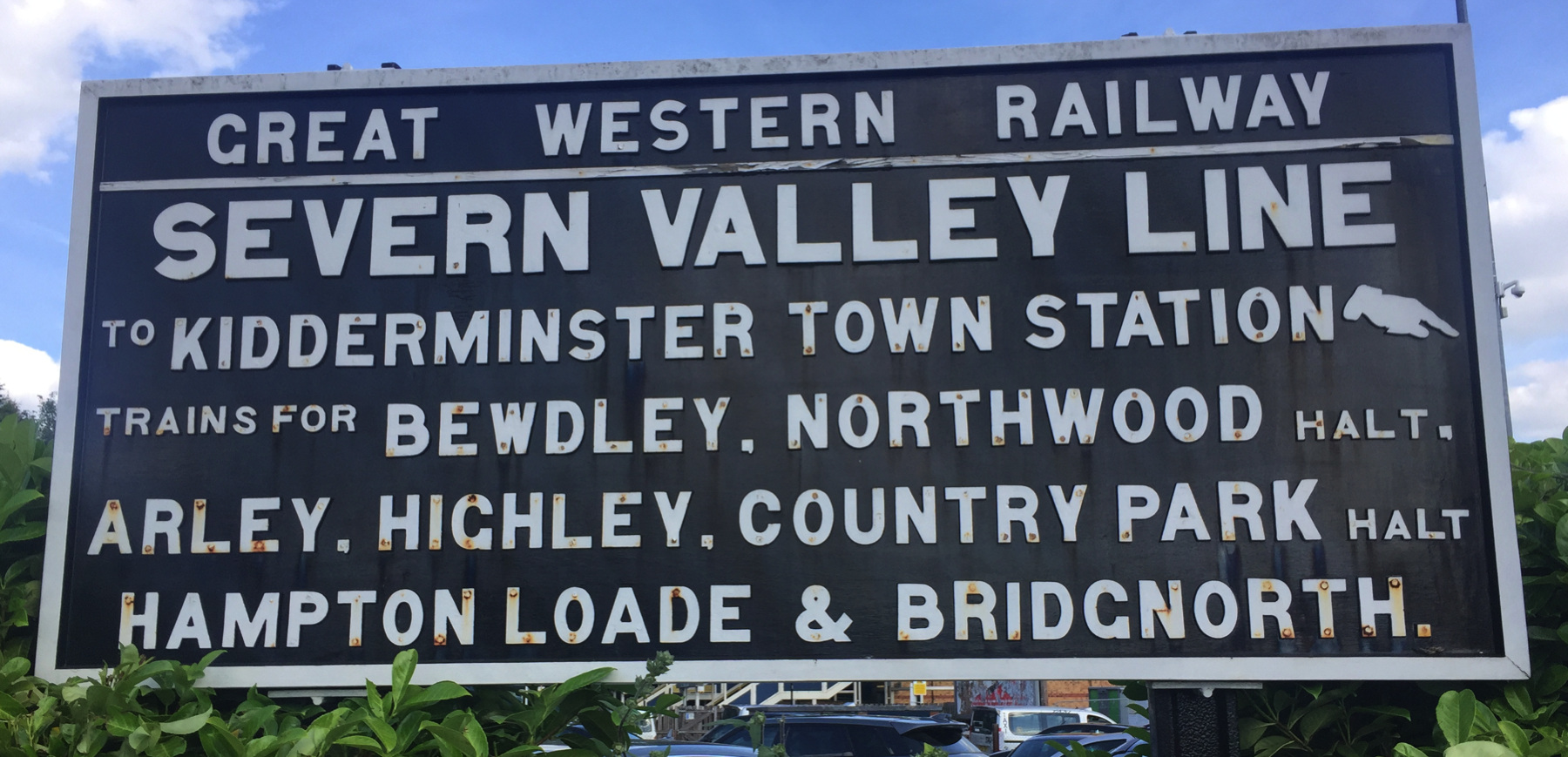
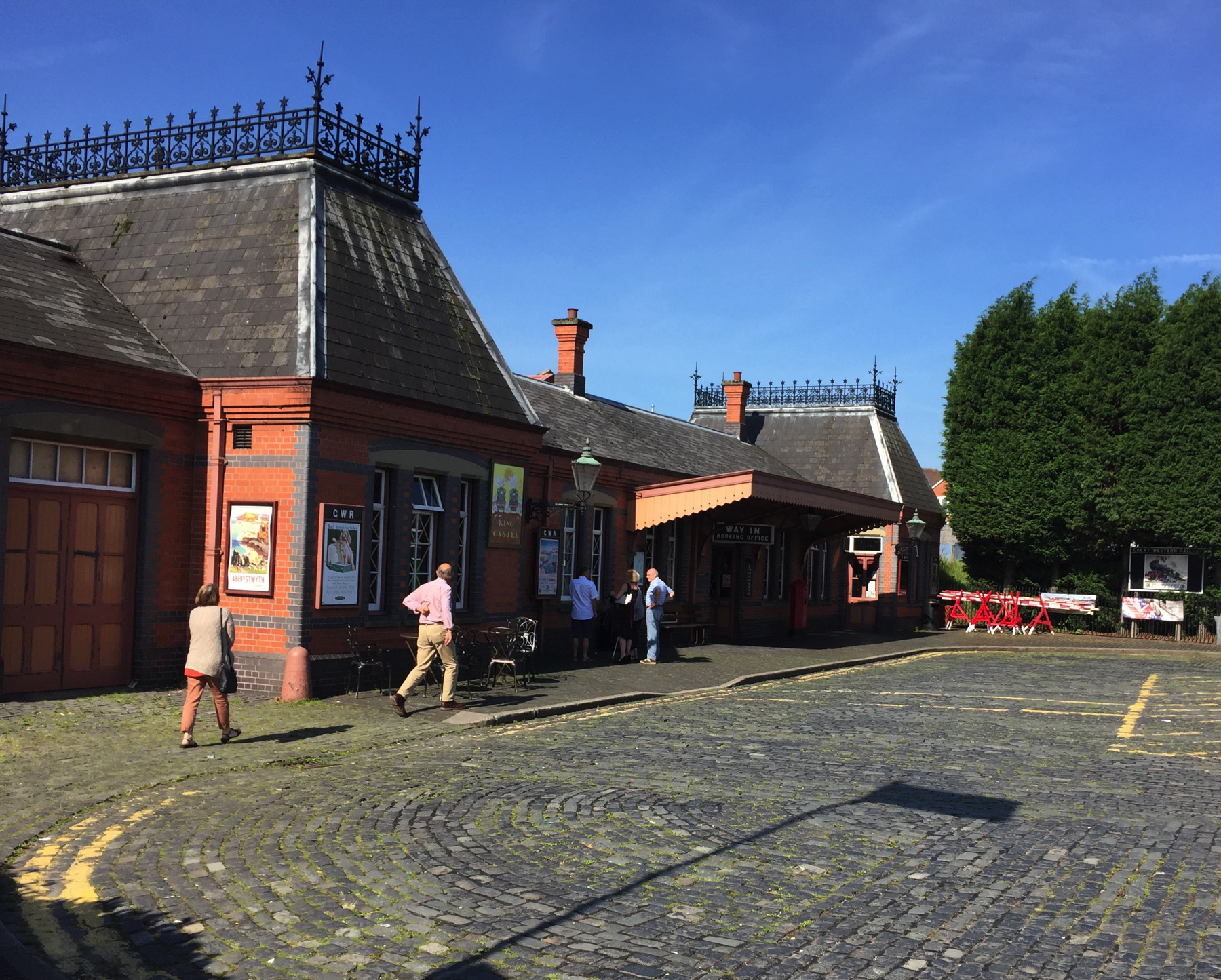
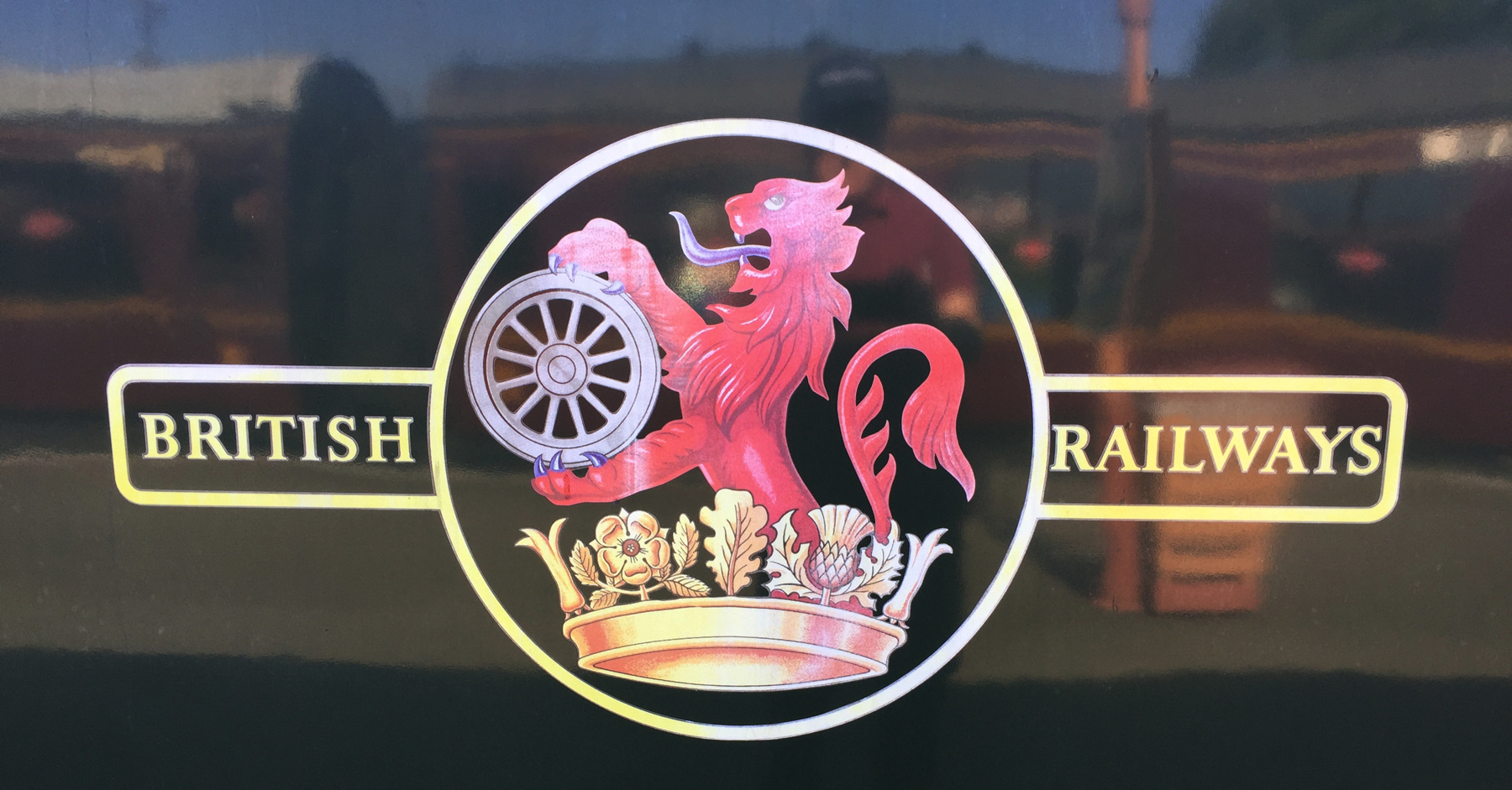
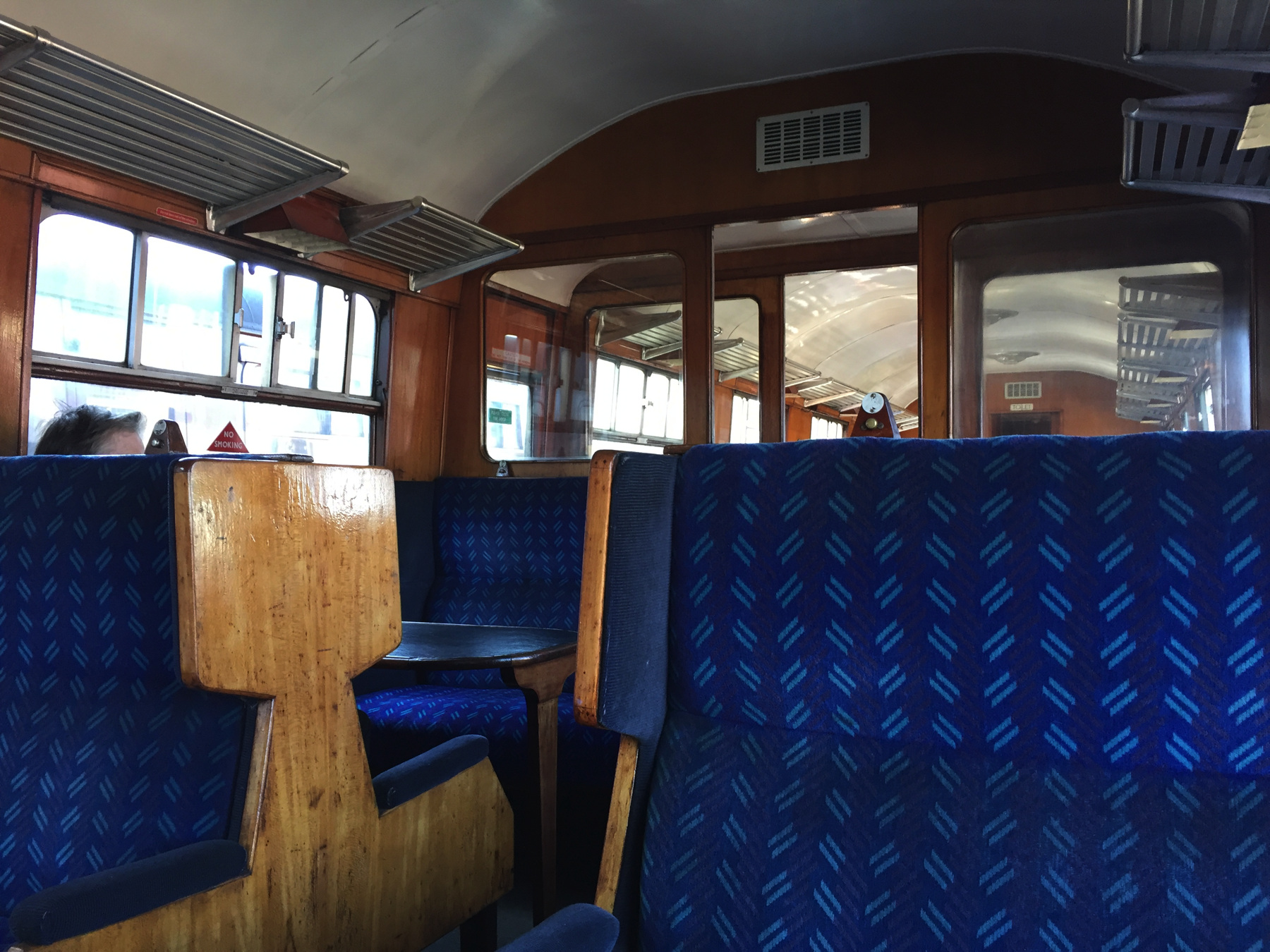
The Severn Valley trains and stations are in absolutely top condition. I was eager to reach Bridgnorth, but I decided I should disembark along the way at Highley to see their museum. I heard an announcement that something like "Ahhley" was next, so I stepped off at Arley. Not Highley.
I'm glad I did. It was a good fifty minutes. Everything at the station has been carefully arranged to mimic life a century ago or more: railway employees in uniform, flowers in the boxes, a well-kept stone station house, some luggage on the platform waiting for the train. But more than that, there was the quiet. I was unexpectedly at peace. I walked with no reason to hurry. I went over the old arched road bridge and through a garden to the platform on the other side. A path near the far end brought me to a small shelter dug partway into the earth, of the type used in the last world war. Just beyond I saw a pheasant dart into the greenery. Looking across the tracks I saw grassy fields with sheep, and across the Severn from that the small village of Arley.
As I walked back to the platform where I arrived, I was relaxed and ready for anything. I had come in behind a heritage diesel. The next train would have a steam locomotive.
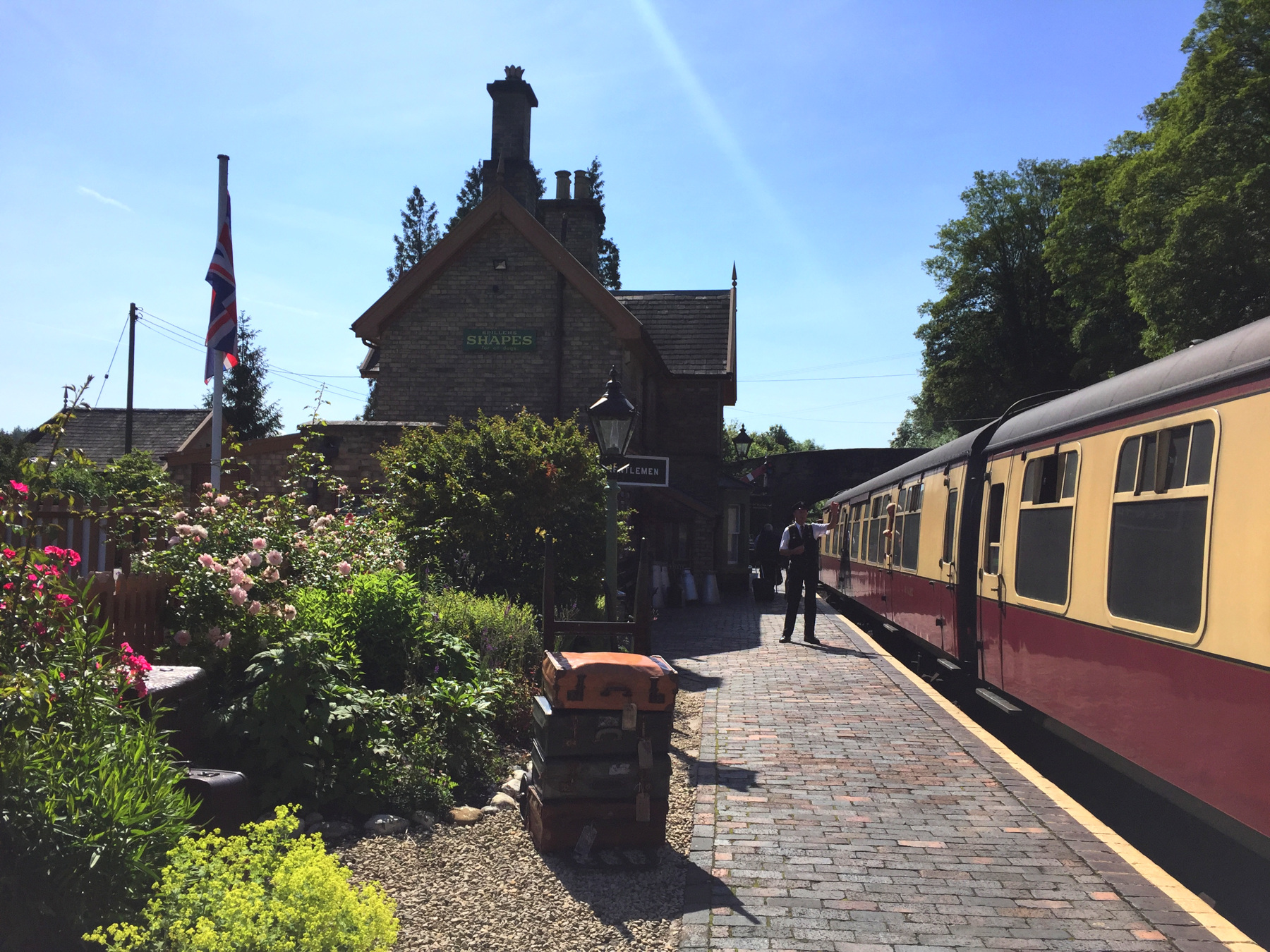
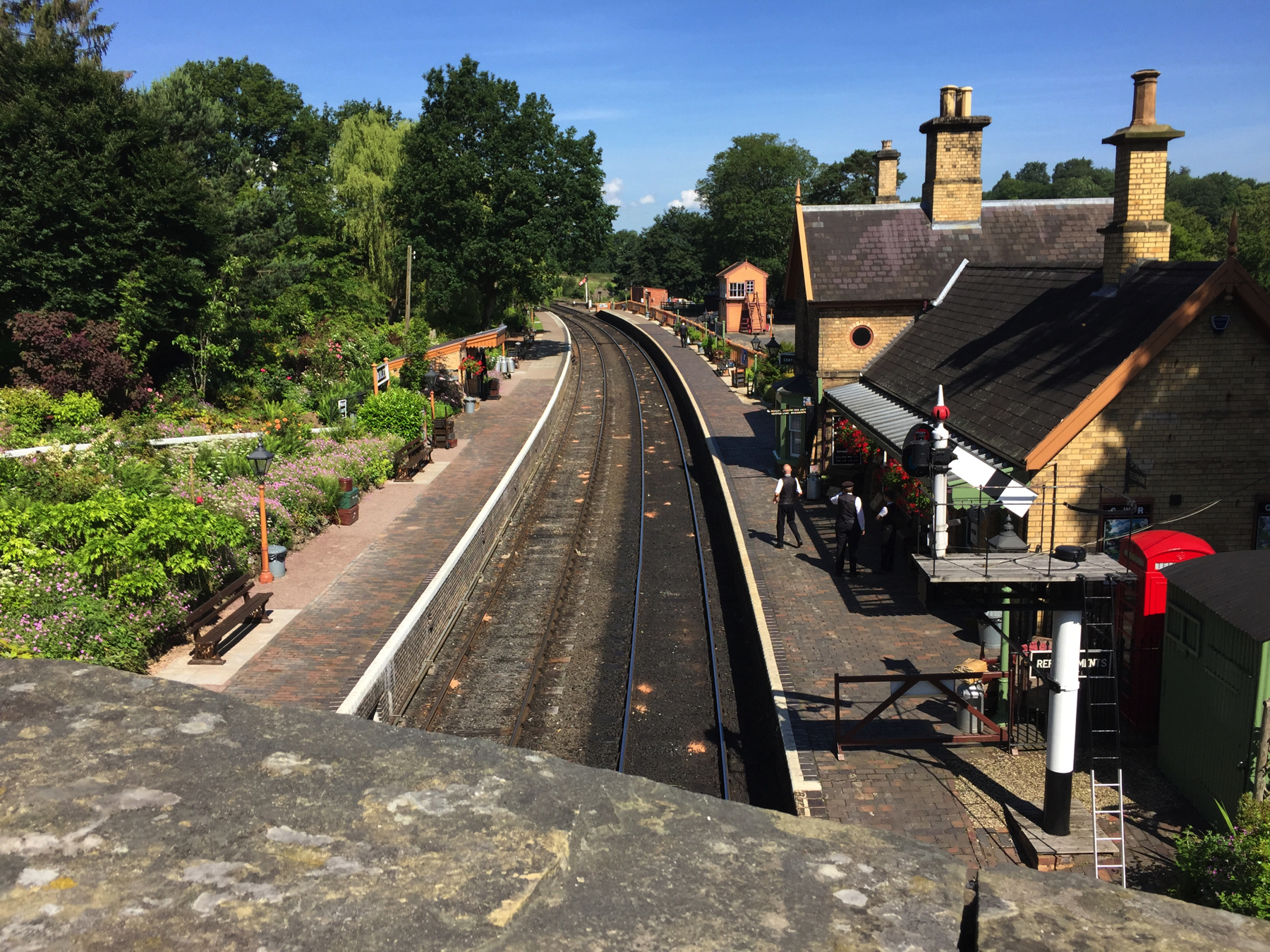
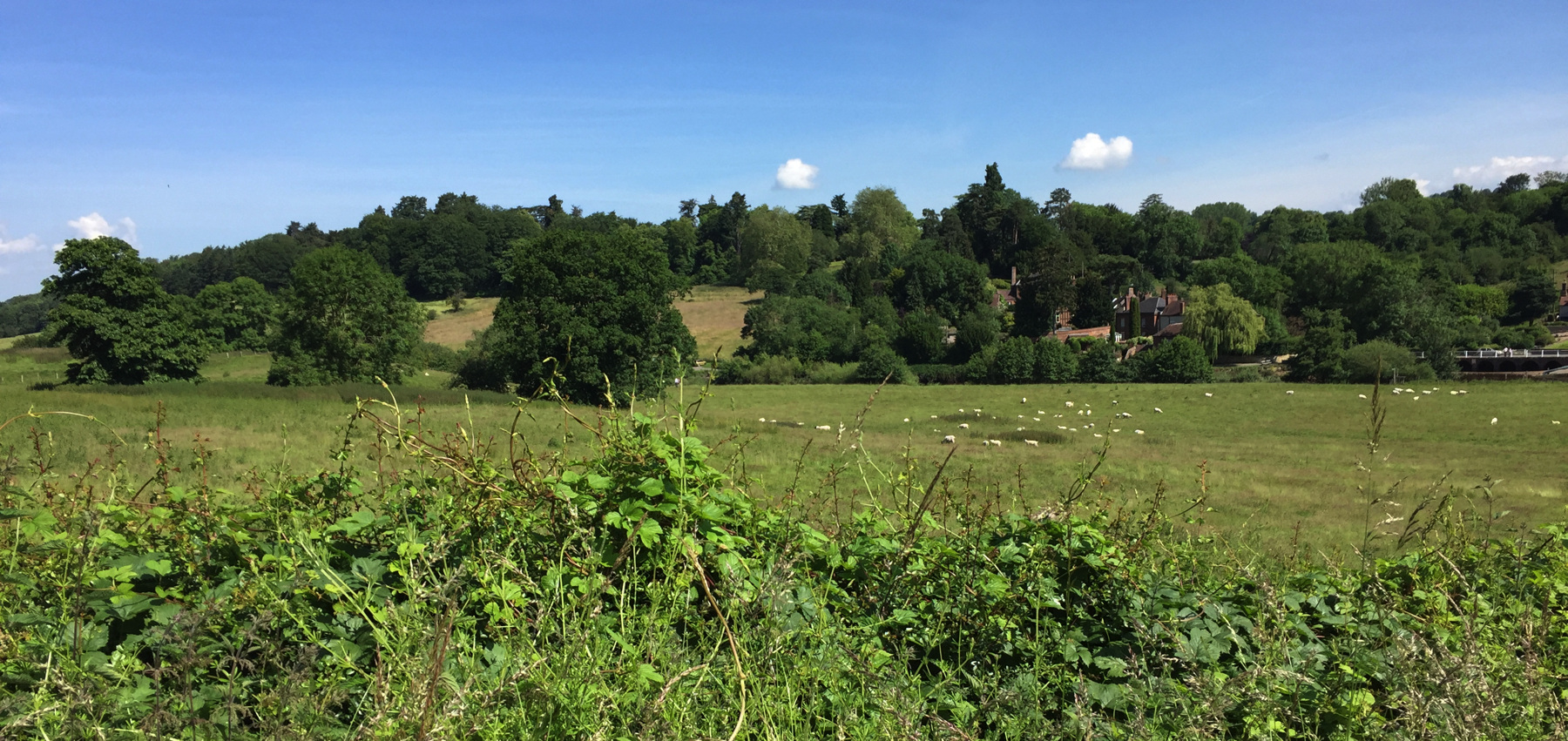
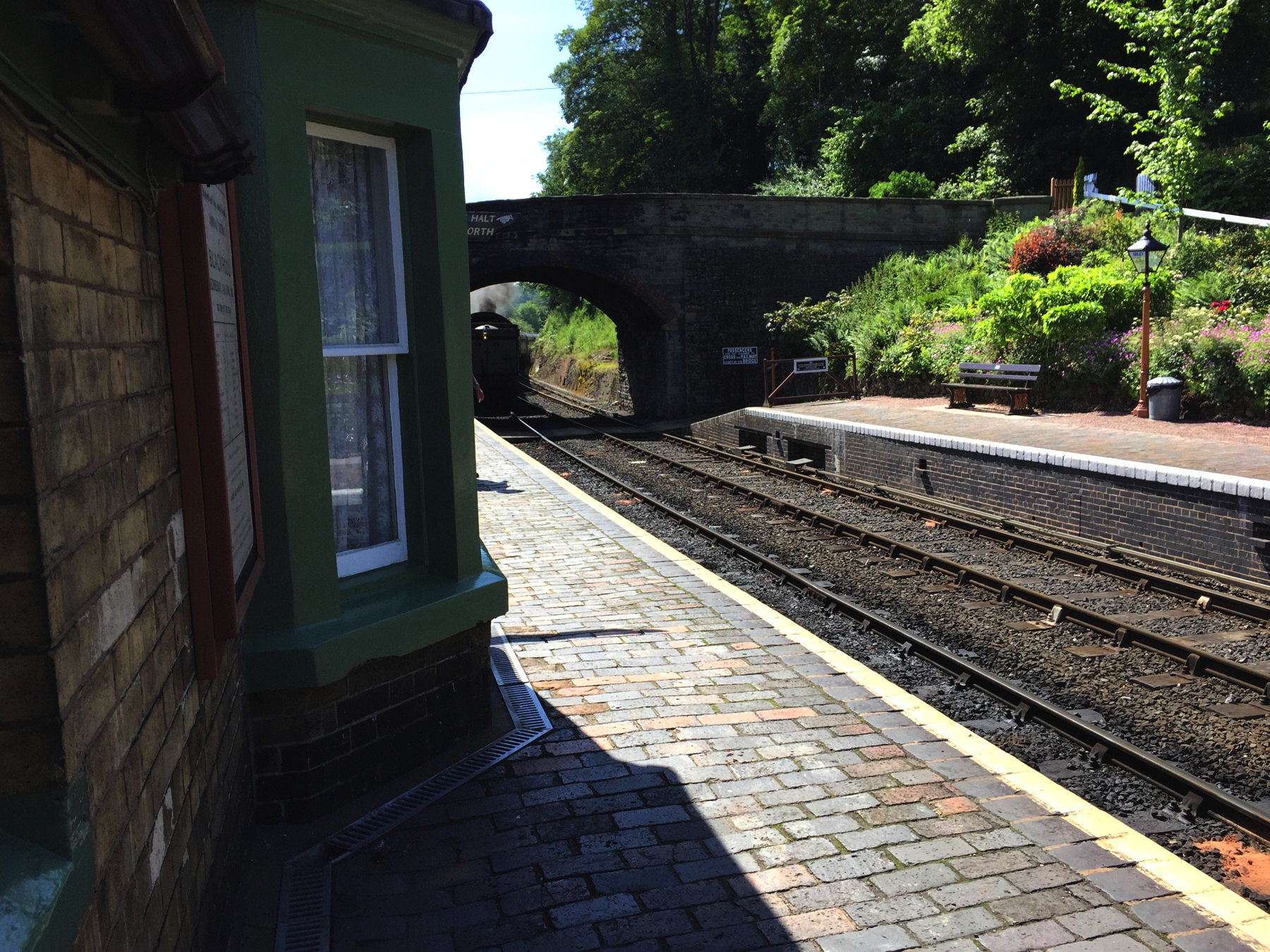
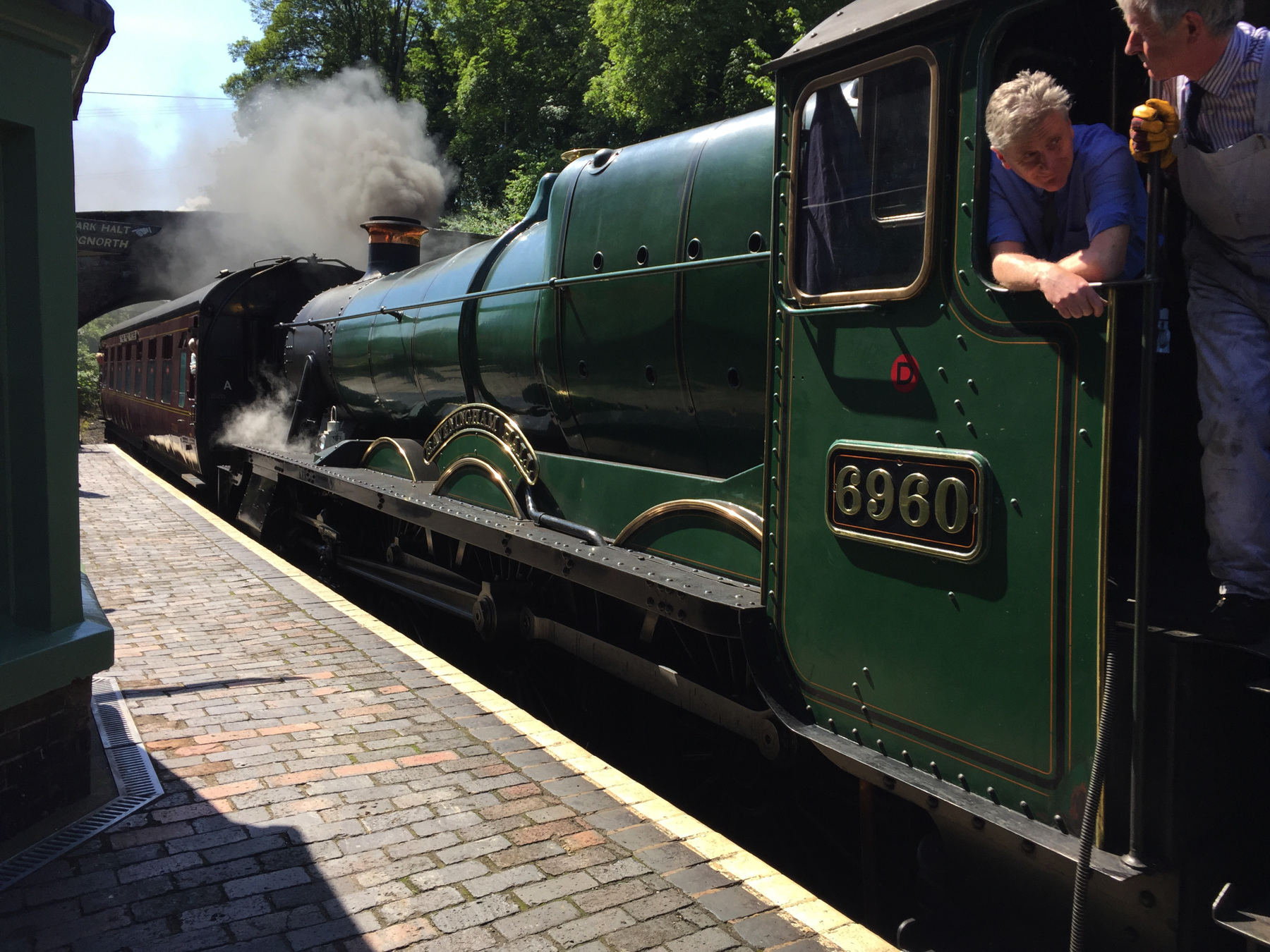
I was ready for anything but this. The engine came in tender first! There are no turntables at the terminals, so this engine always points toward Kidderminster. The Severn Valley's web site even lists which direction each engine is facing, for those who need to know. I see on the list (reading, after I got home) that this particular engine was visiting from the West Somerset Railway.[note 1] By the way it looks like right hand running here, but this is a passing point on a mainly one-track line, and the Severn Valley favors putting the train on this side with the station house.
I'll put here below just one thing from the museum. A London Transport steam locomotive! This tank engine was built in 1929 for the Great Western Railway and was assigned in the London terminal area to handle local freight trains and shunt cars in freight yards. It was sold in 1948 and as engine L95 it moved work trains on London Transport's Metropolitan Line until 1960. Rather than one water tank at the rear, it has tanks on each side of the boiler, a design called pannier tank. Although it is not currently listed as operational, it gives the appearance that it could be fired up and taken out any time.
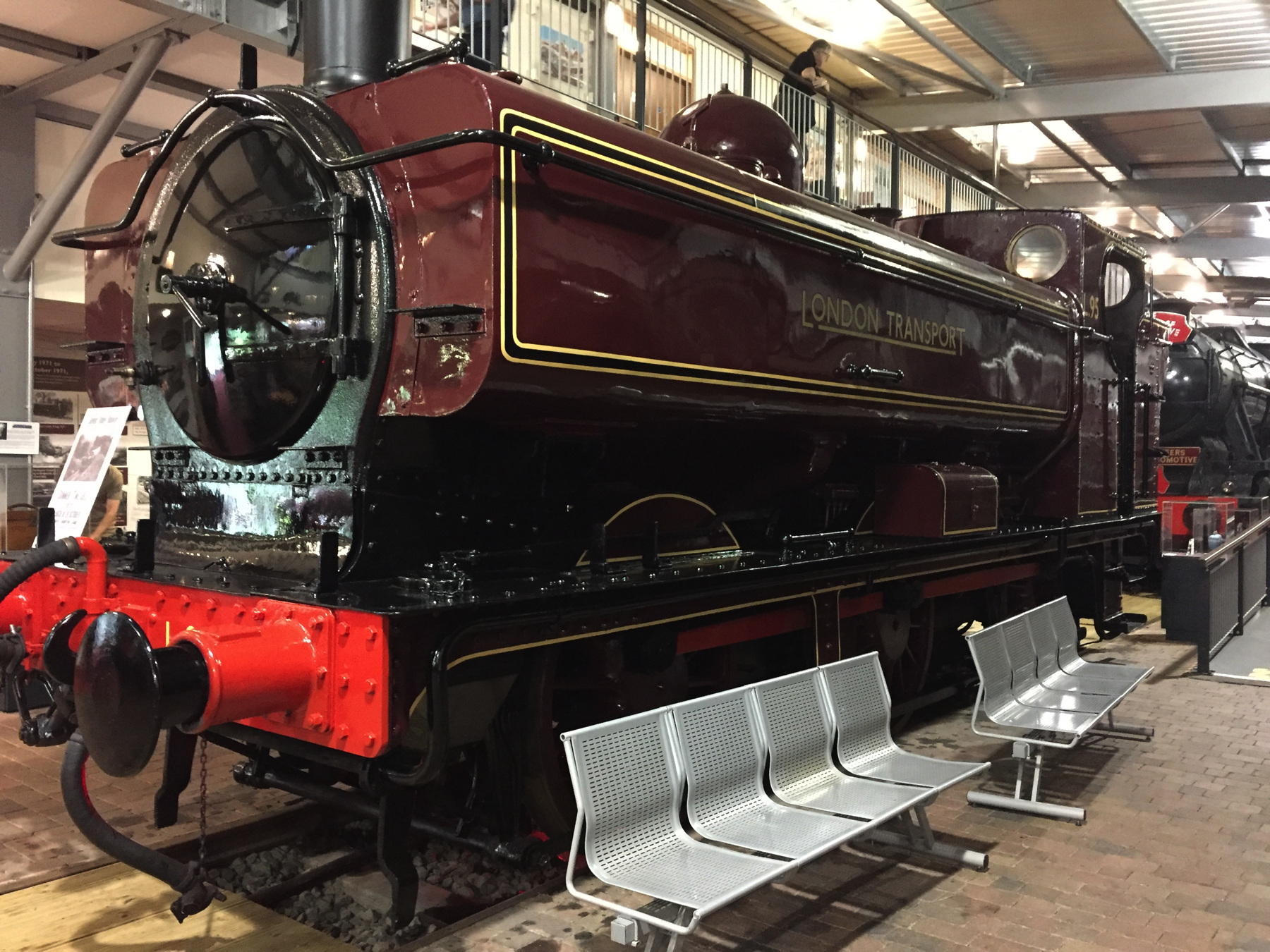
On the way to Bridgnorth I found myself sitting across a table from a woman and her young son. We compared accents and found we were from New Jersey and South Africa, although she was born in Ireland and now lived in Britain. Our main topics were that it was a beautiful day, that this was possibly the best preserved railway ever, and that Brexit was probably going to be a mess. We agreed to get off that last one almost as soon as we started.
The funicular railway operates all year, and from that fact it will not be a surprise to learn that the town of Bridgnorth is split into a High Town and a Low Town, divided by a river and by a few hundred feet elevation—much the same situation as we saw at Lynton and Lynmouth. The shortest walk from Bridgnorth station to the funicular is the footbridge over a gorge and then roads or paths on either side of the castle to the middle of town at Bank Street. I chose West Castle Street.
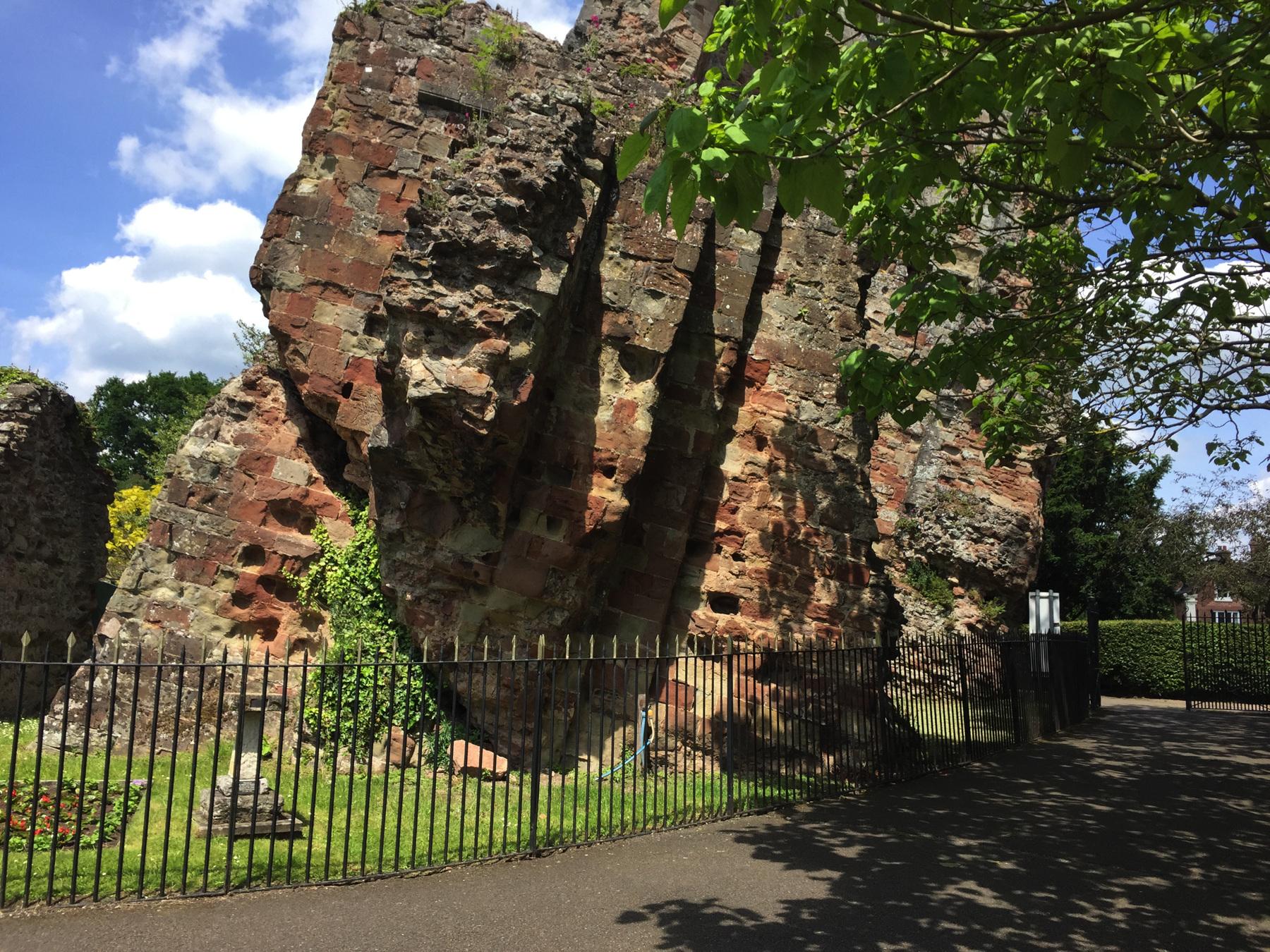
Would you walk on the path to the right? The twelfth century castle at Bridgnorth was held by royalists during the Civil War, and after Cromwell's army took it in 1646 he ordered it destroyed. The job was not quite finished. That happens. What is left of the tower has been leaning like this for more than 370 years. I saw a young couple start to go that way and then turn back. I asked them and they said they just didn't want to try it, and we laughed. You know that laugh. They had years in front of them. I am a man who lives for danger, so I took the chance and have lived to tell the tale. The Leaning Tower of Bridgnorth has four times the lean of its rival in Pisa (according to Wikipedia, relying on a television program, so it must be true).
Bridgnorth turns up the quaint dial on the High Street. I am usually suspicious about half-timbered buildings, and in this case it was because of damage to the town during the Civil War and their clean horizontal lines. The white arch in the first picture is Town Hall, which, it is said, was built as a barn in 1650 (in the middle of the High Street?) but has served its current purpose for centuries. If that's real maybe some of the others are. The arch in the second picture is the only surviving gate of the old town walls, although according to the museum itself what we see are sandstone outer walls from 1911 and faux battlements added after that date.
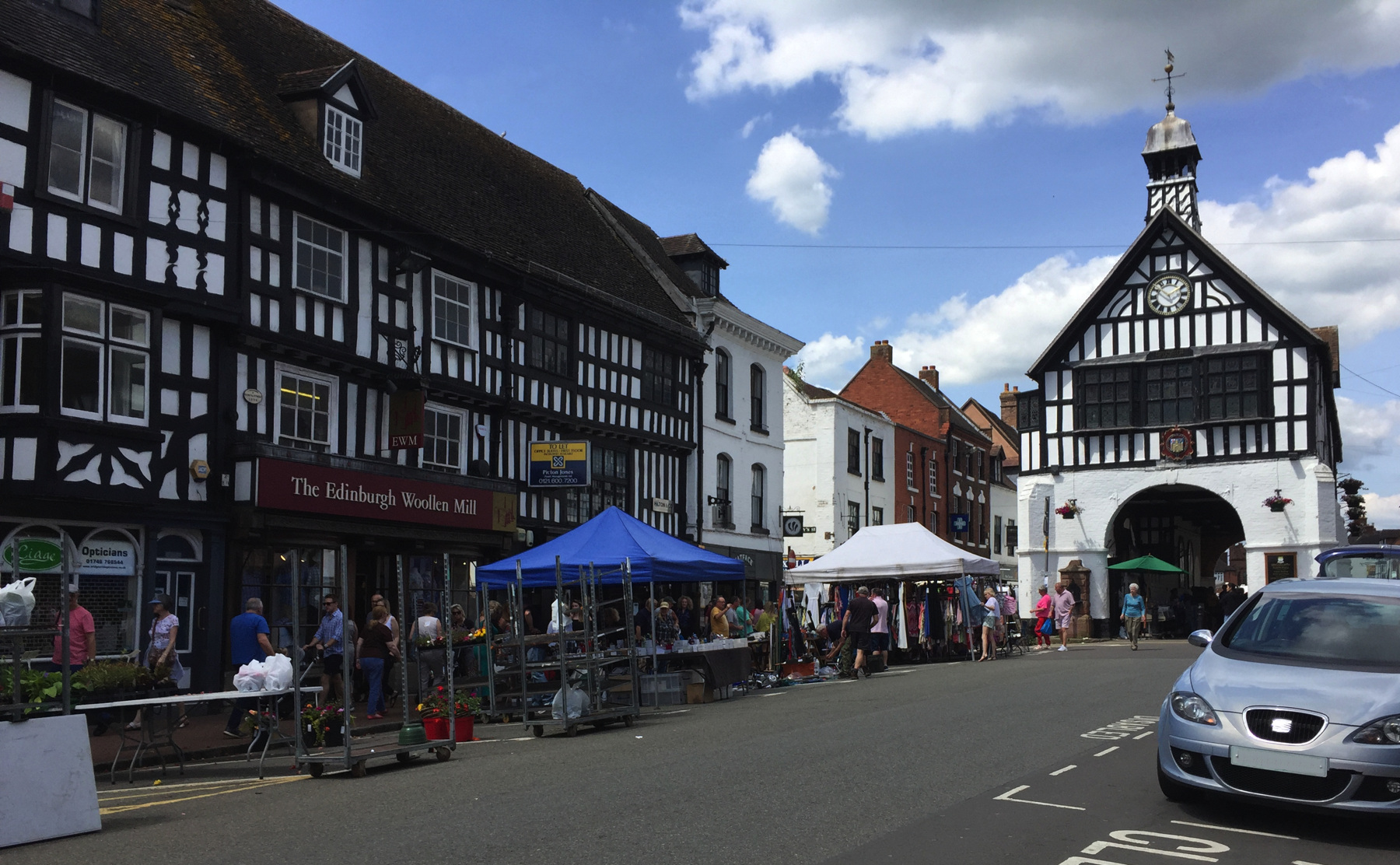
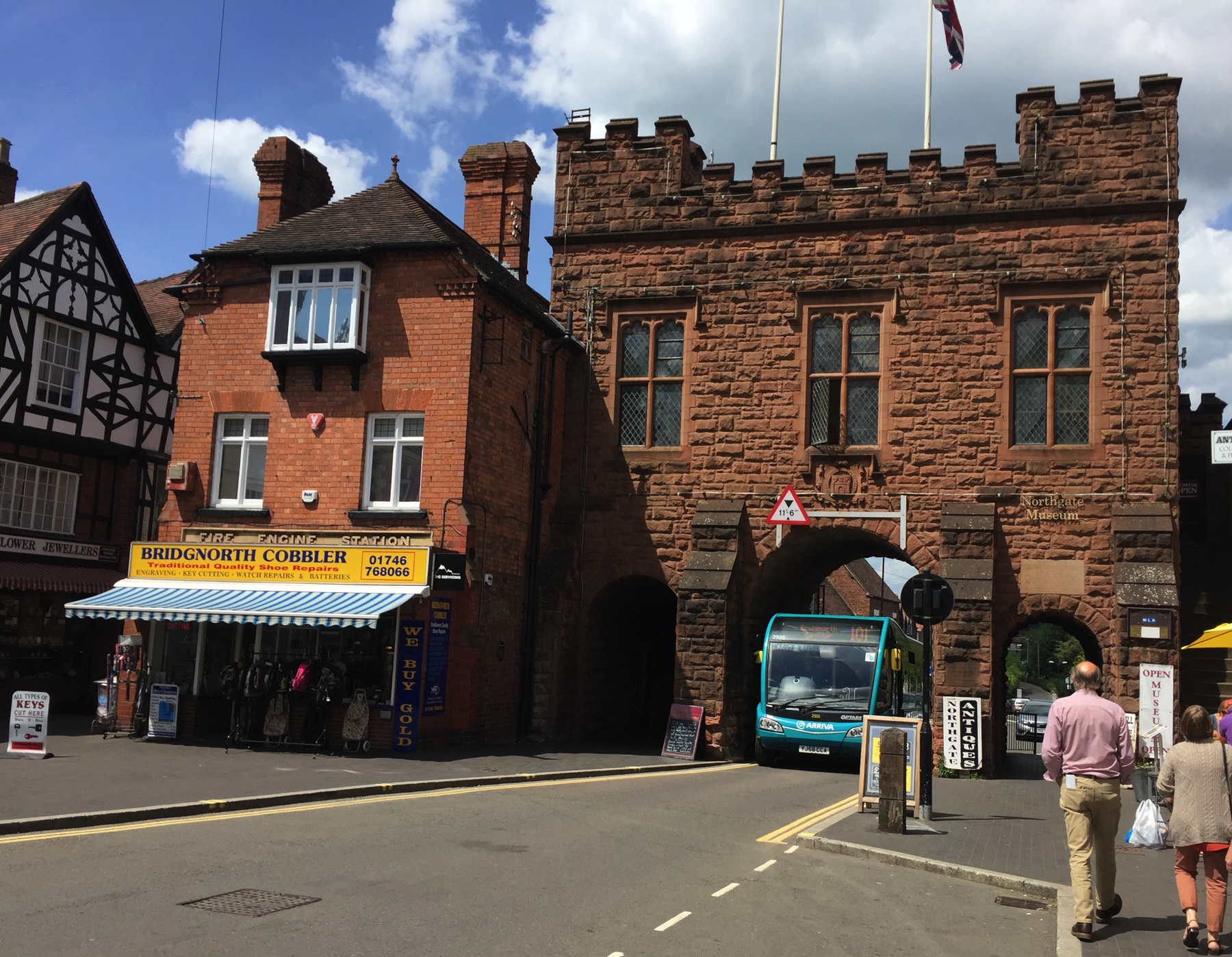
You don't have to take the funicular. There's this. That is not the bottom down there.
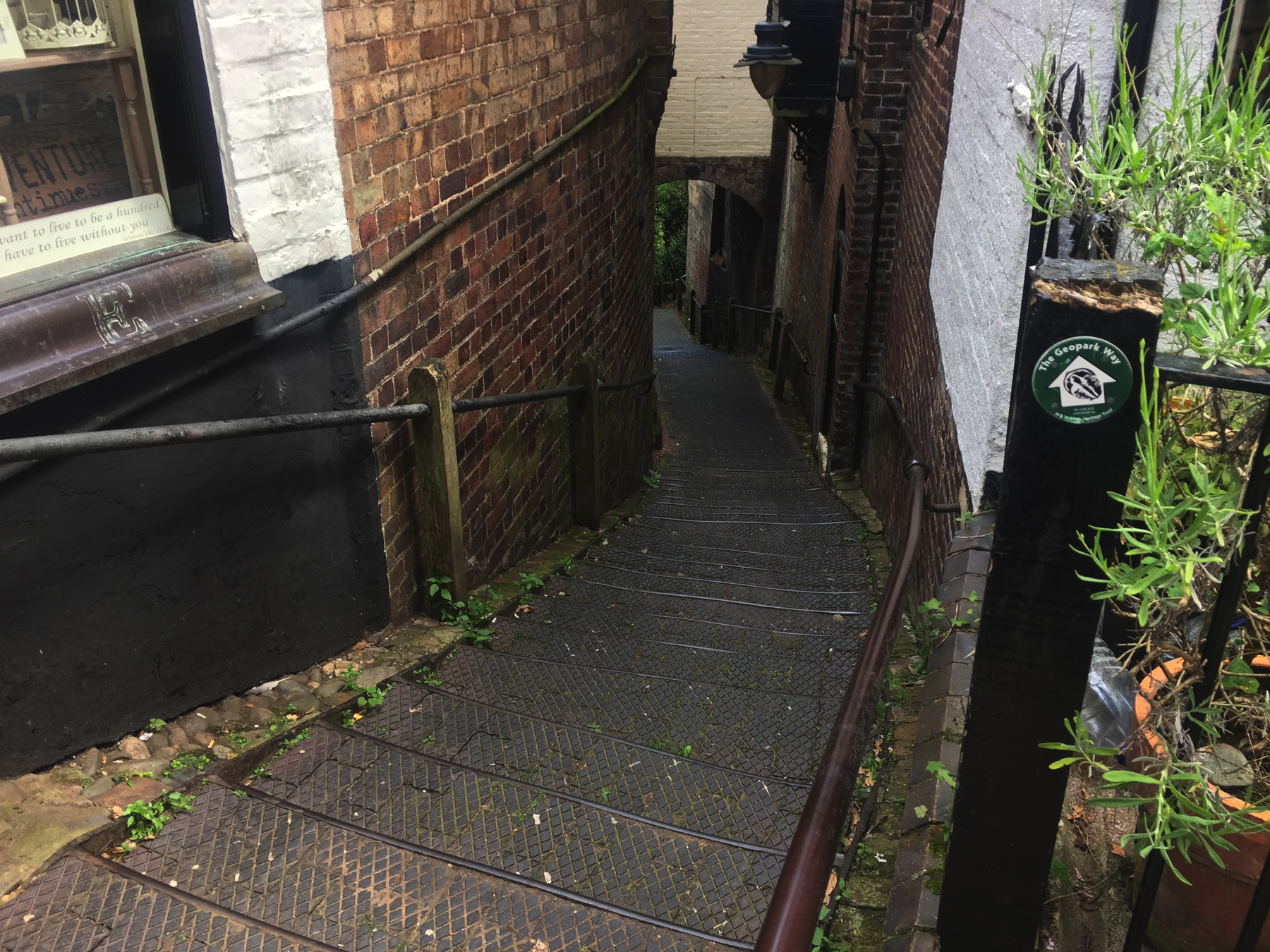
All right, enough. Here it is. The Cliff Railway. If you are wondering what all those people are looking at, I was too. You have to walk a little past the entrance and then look back. (Or if you went around the east side of the castle and missed the High Street, you came up from that side.)
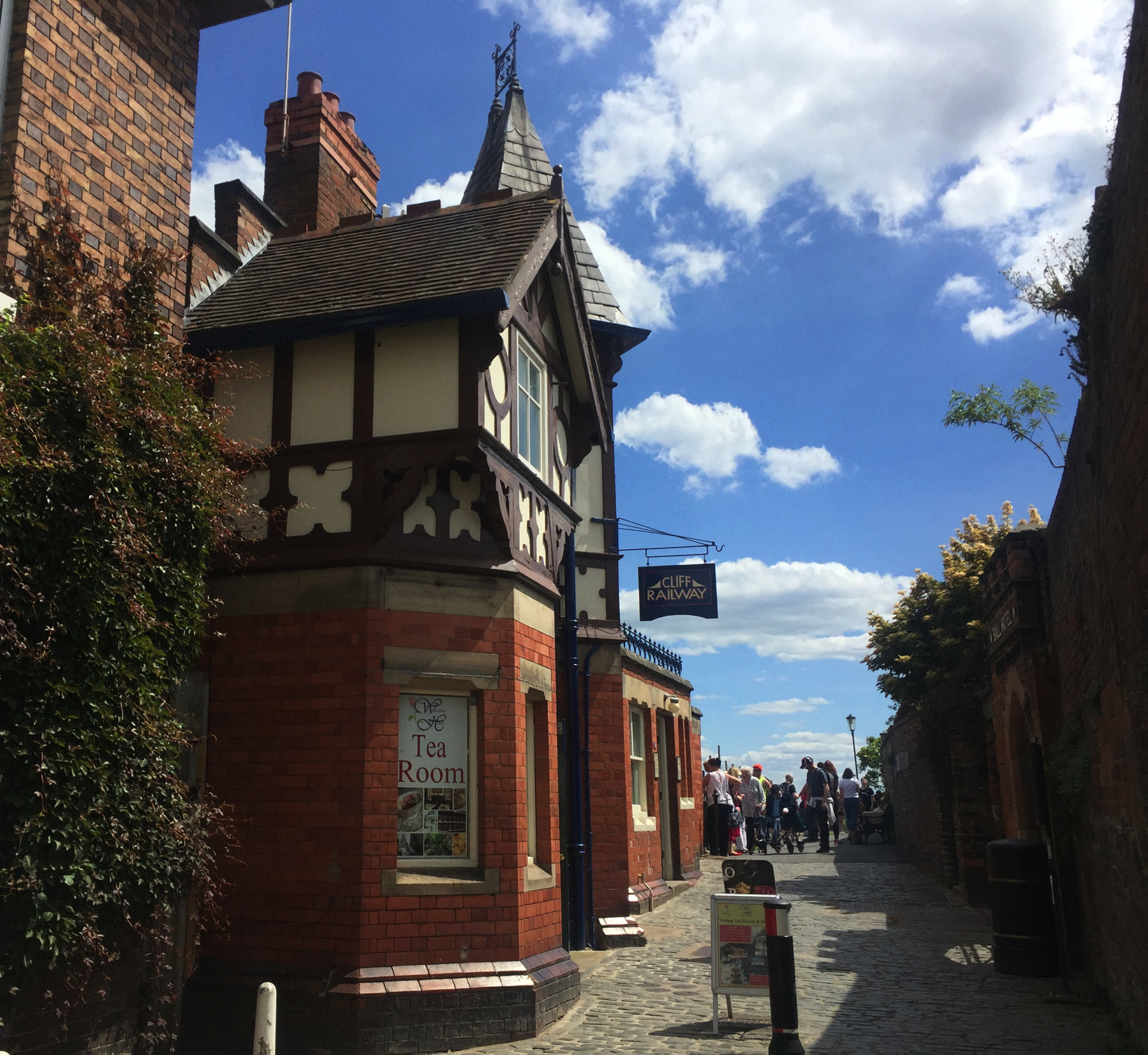
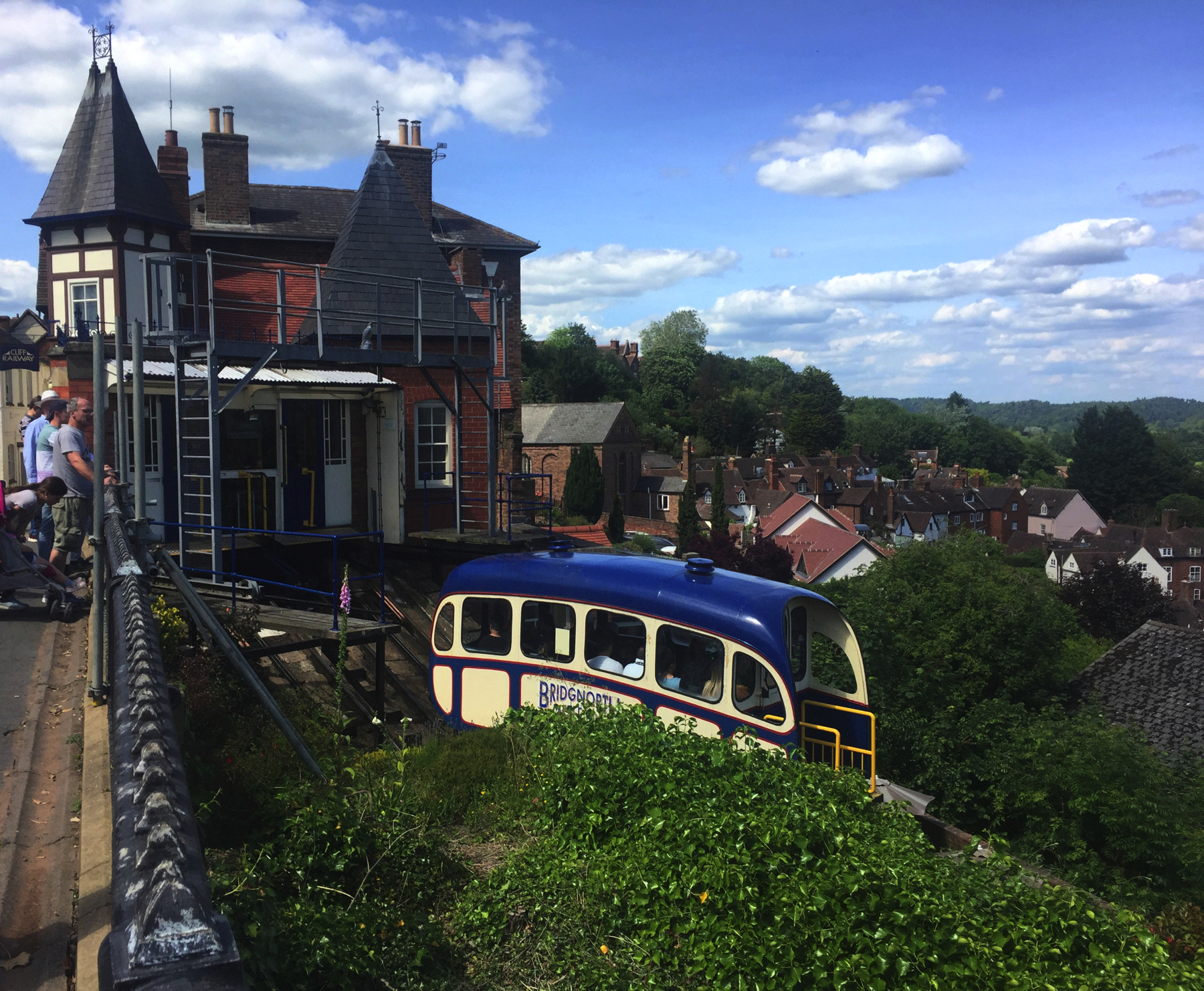
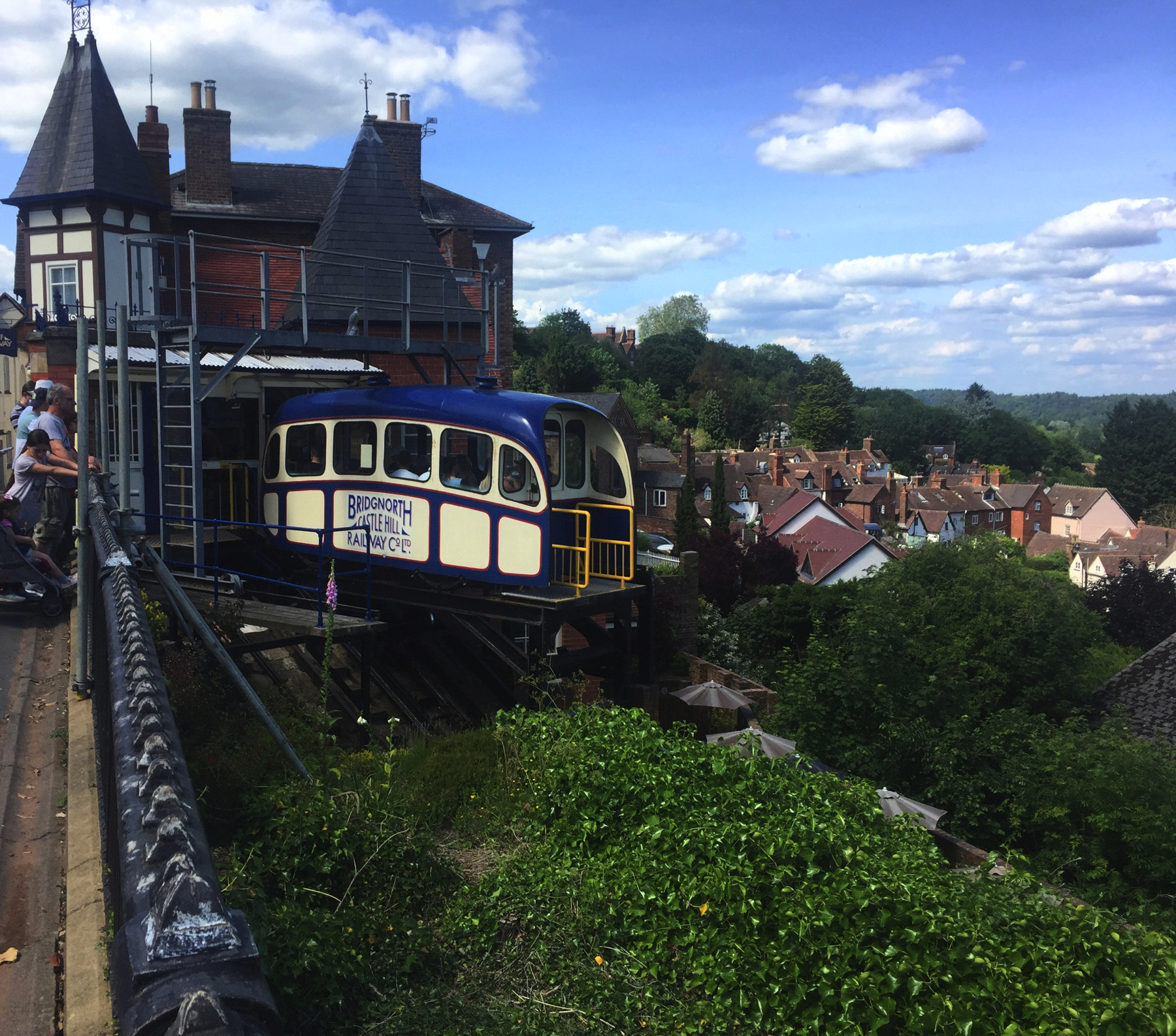
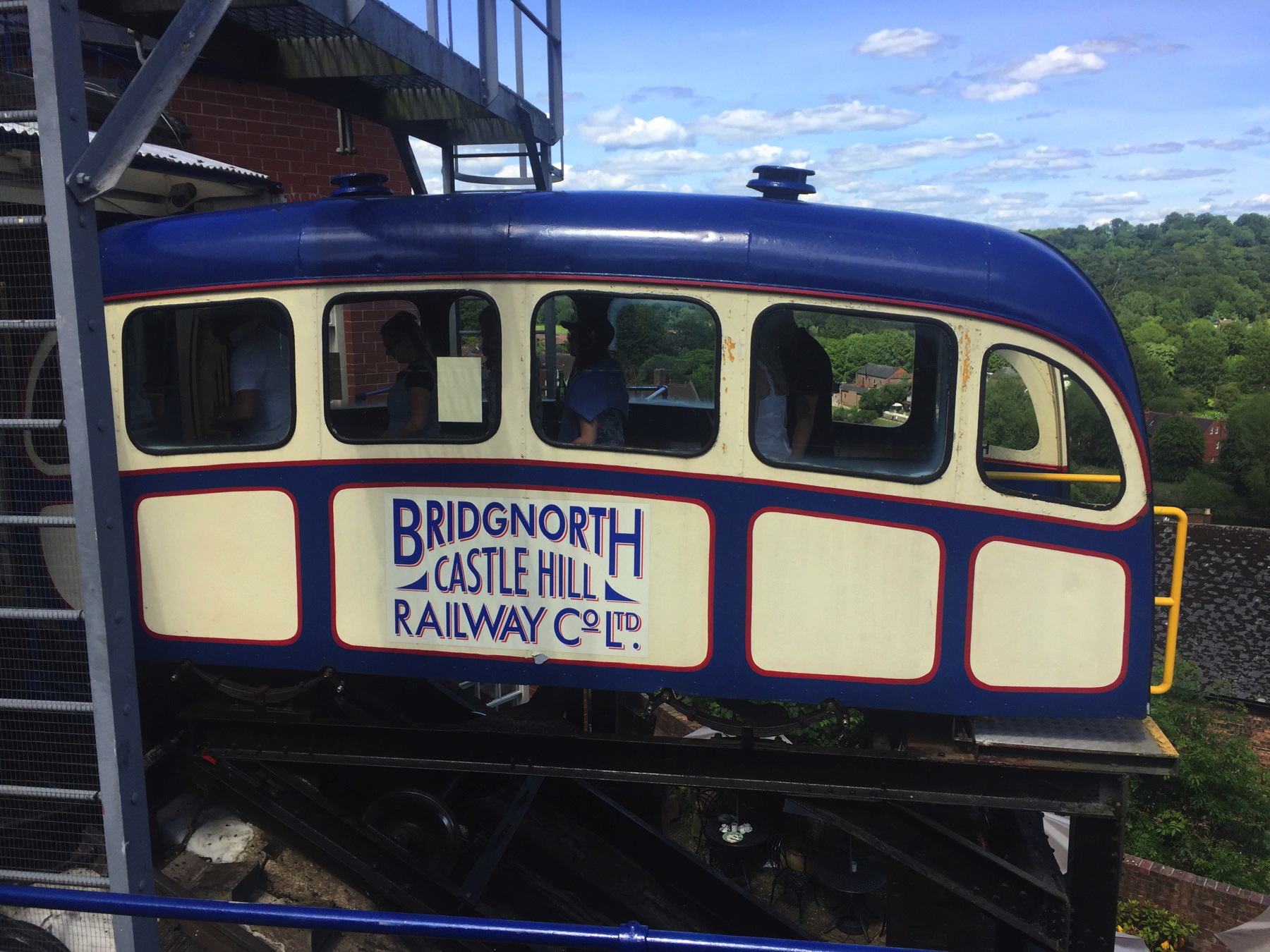
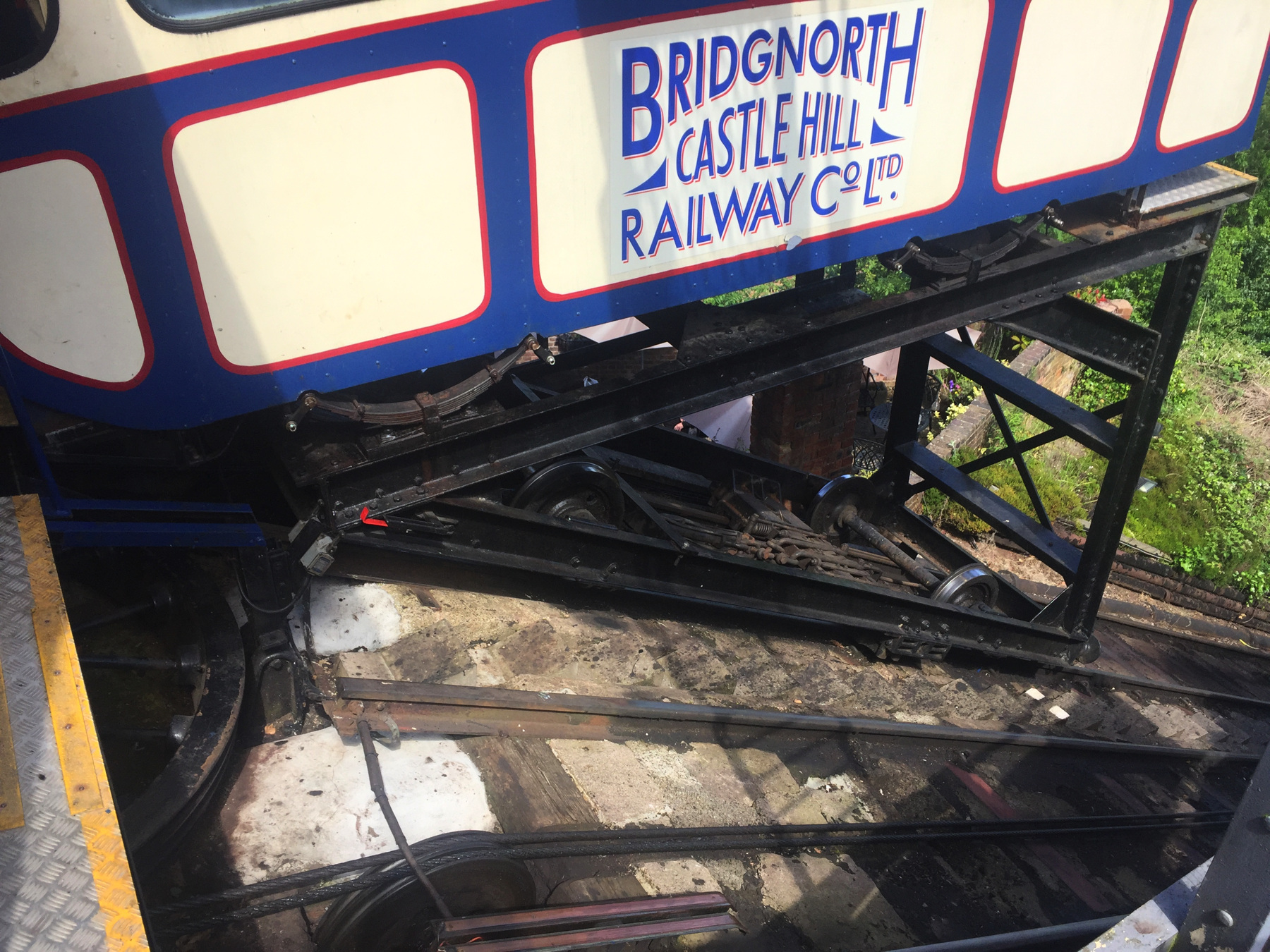
Nice look there at the undercarriage. The wheels are under the lower end and the middle. Of course that's where the weight is. The rails don't even go all the way to the top since they don't need to. At the bottom, see the pair of wire ropes that come up from the car at the lower station and over that pulley, on their way to the back of that big horizontal wheel and the upper end of the car we see here.
These fantastic cars were built in 1955 using the monocoque design then in vogue since the 1930s and used in aircraft and bus bodies, in which the outer shell is an integral part of the structure. The characteristic rounded lines remind me very much of the kind of bus I saw in my childhood. The purpose of it is to reduce weight. It's a welcome feature on a funicular... or is it? Don't you want a good weight on the car going down? No other funicular in Britain has cars like this.
Only on the side of the cars do we get the name Bridgnorth Castle Hill Railway Co. Ltd. The stations have just Cliff Railway, which is the name that I use.
Let's ride. First we have to wait, since a car just left. Down there, across the Severn, is Lower Town. Only the last of these is from the car I rode down on the left side track.
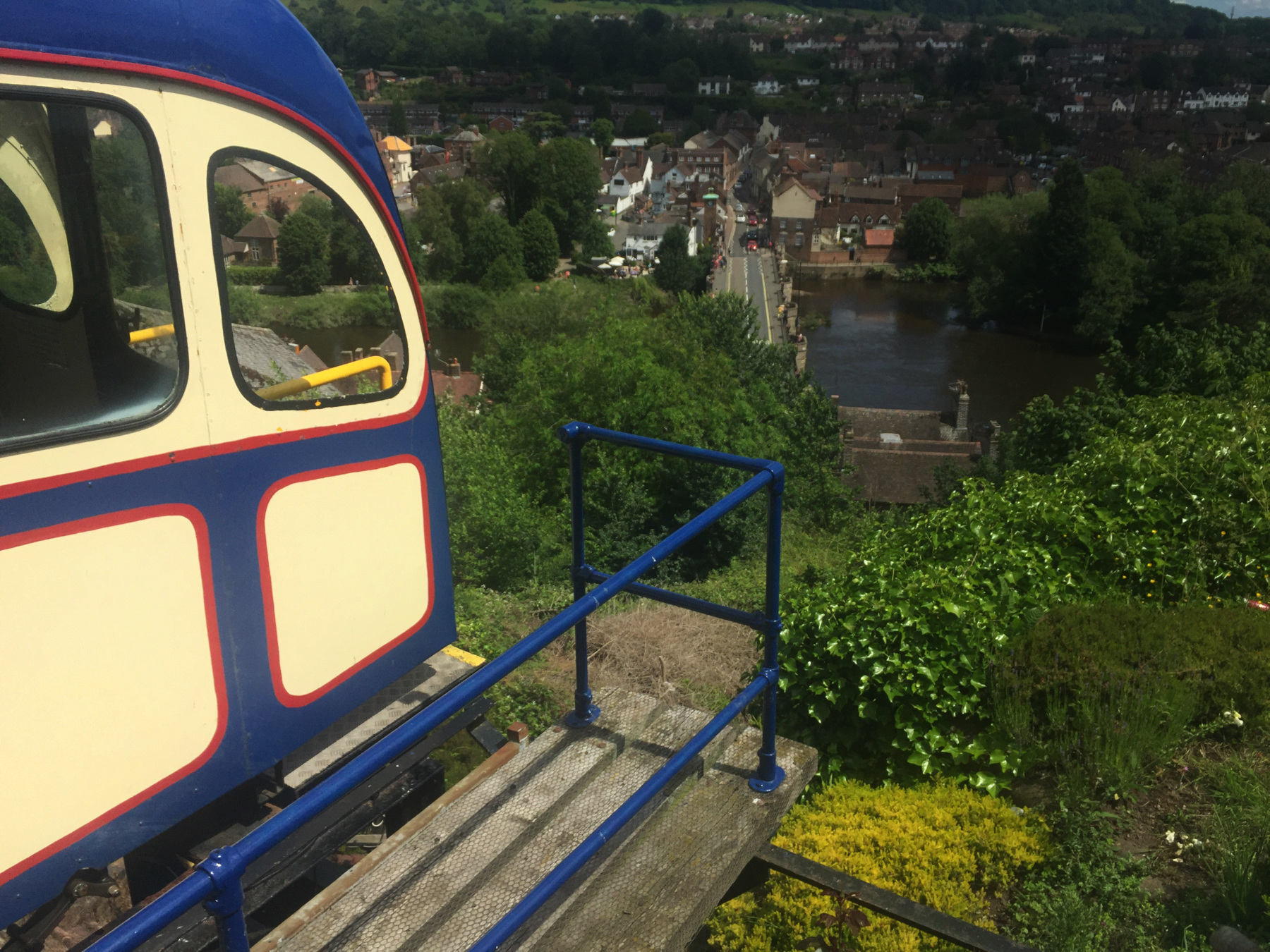
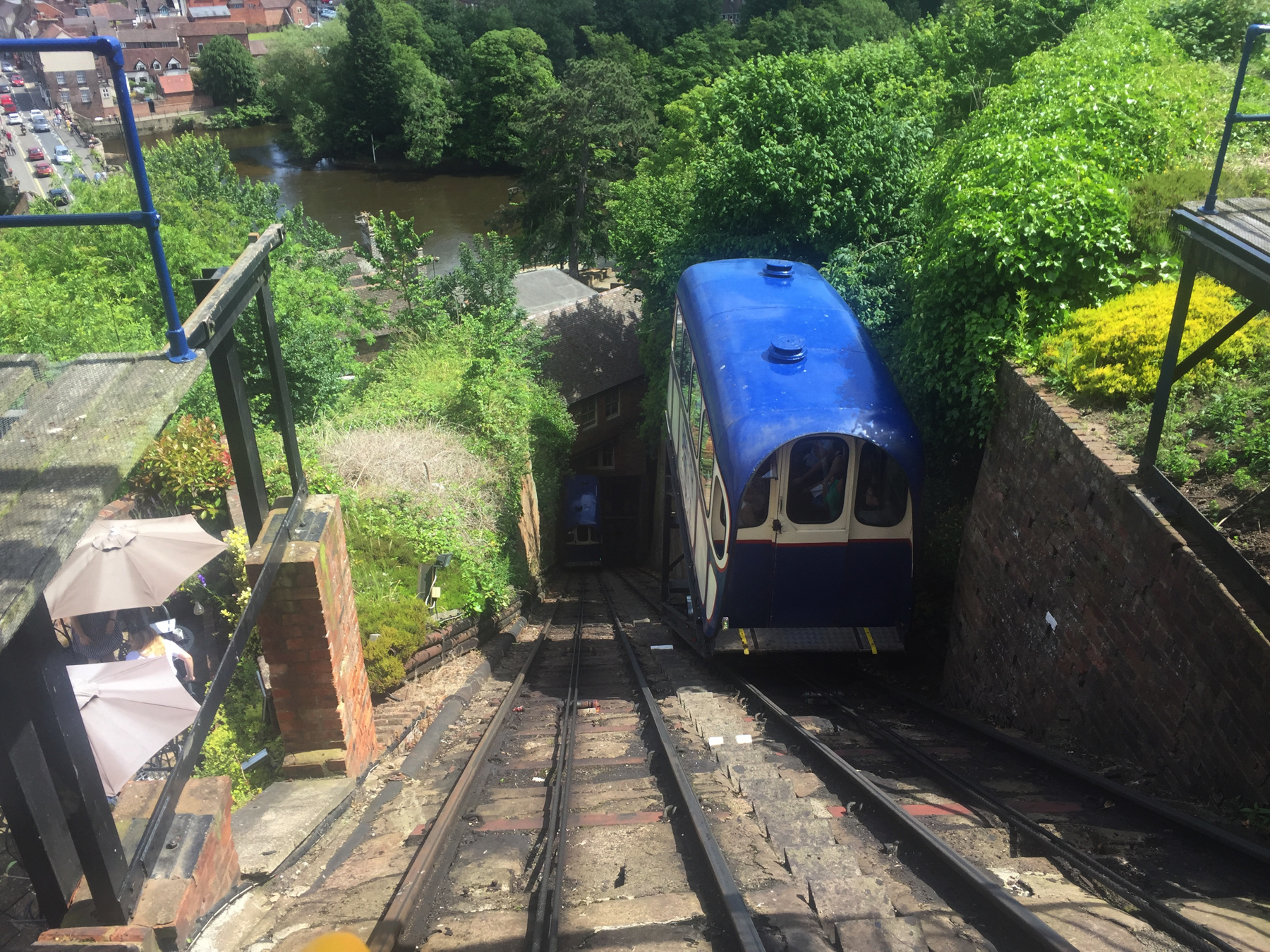
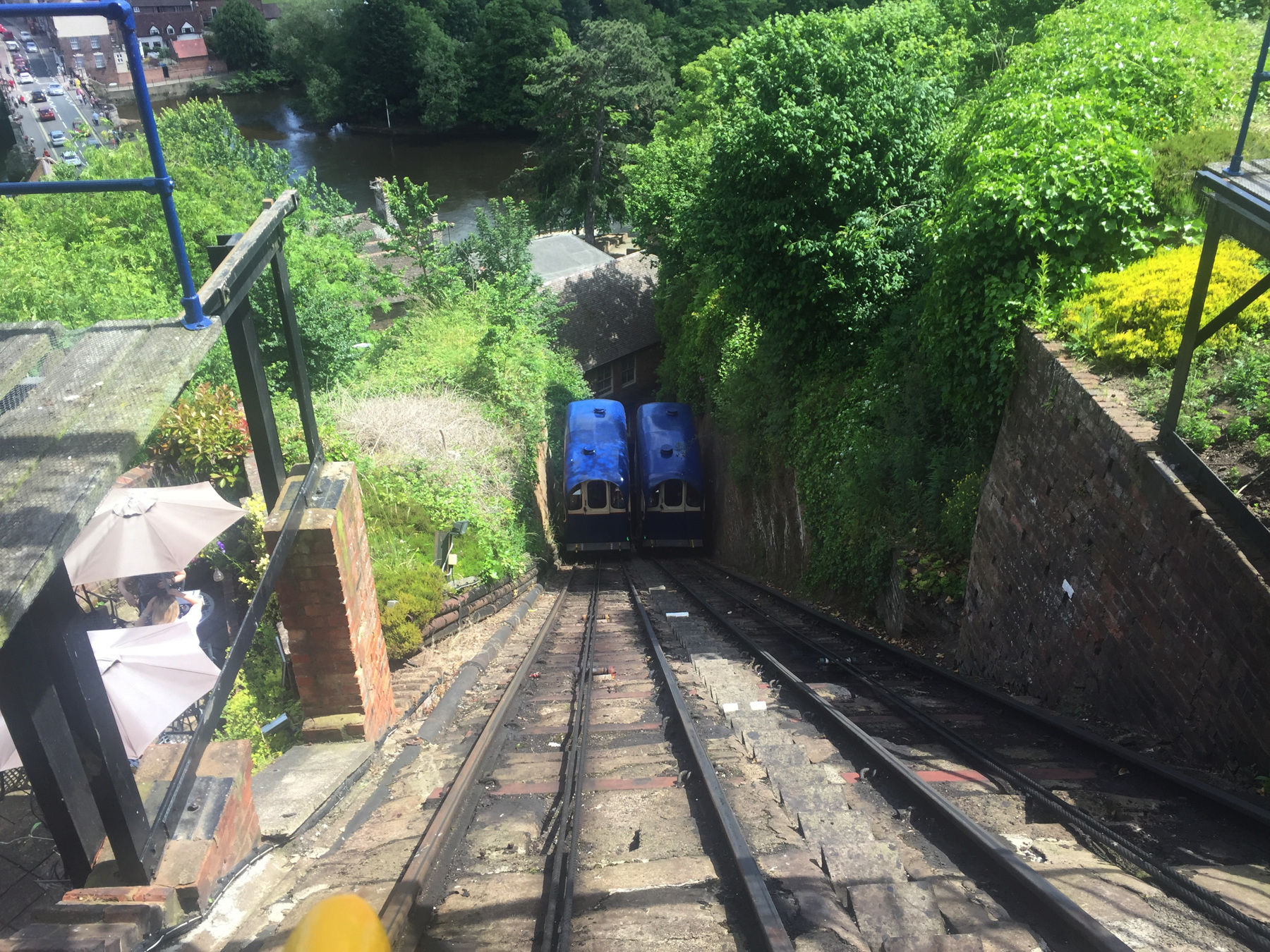
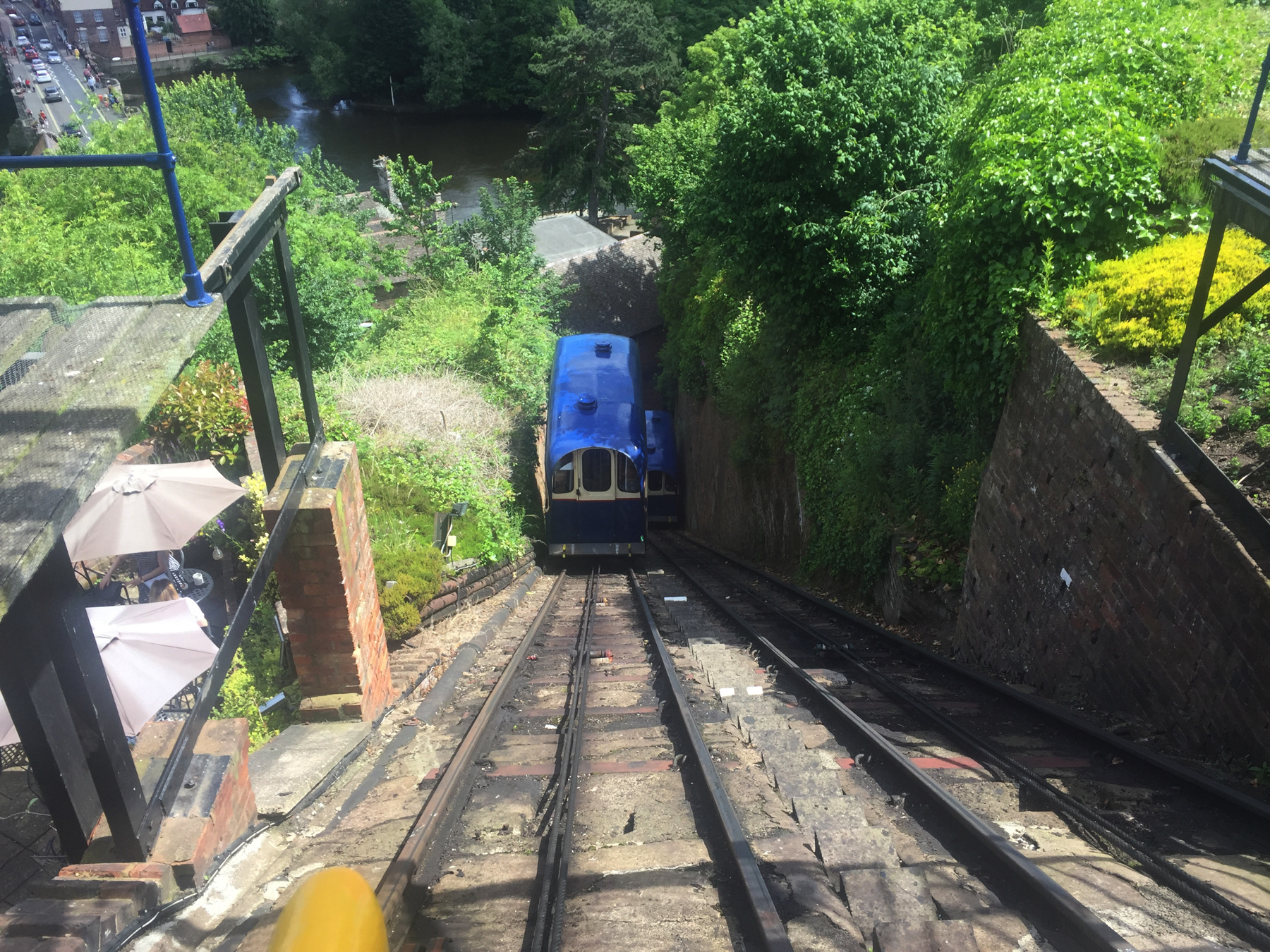
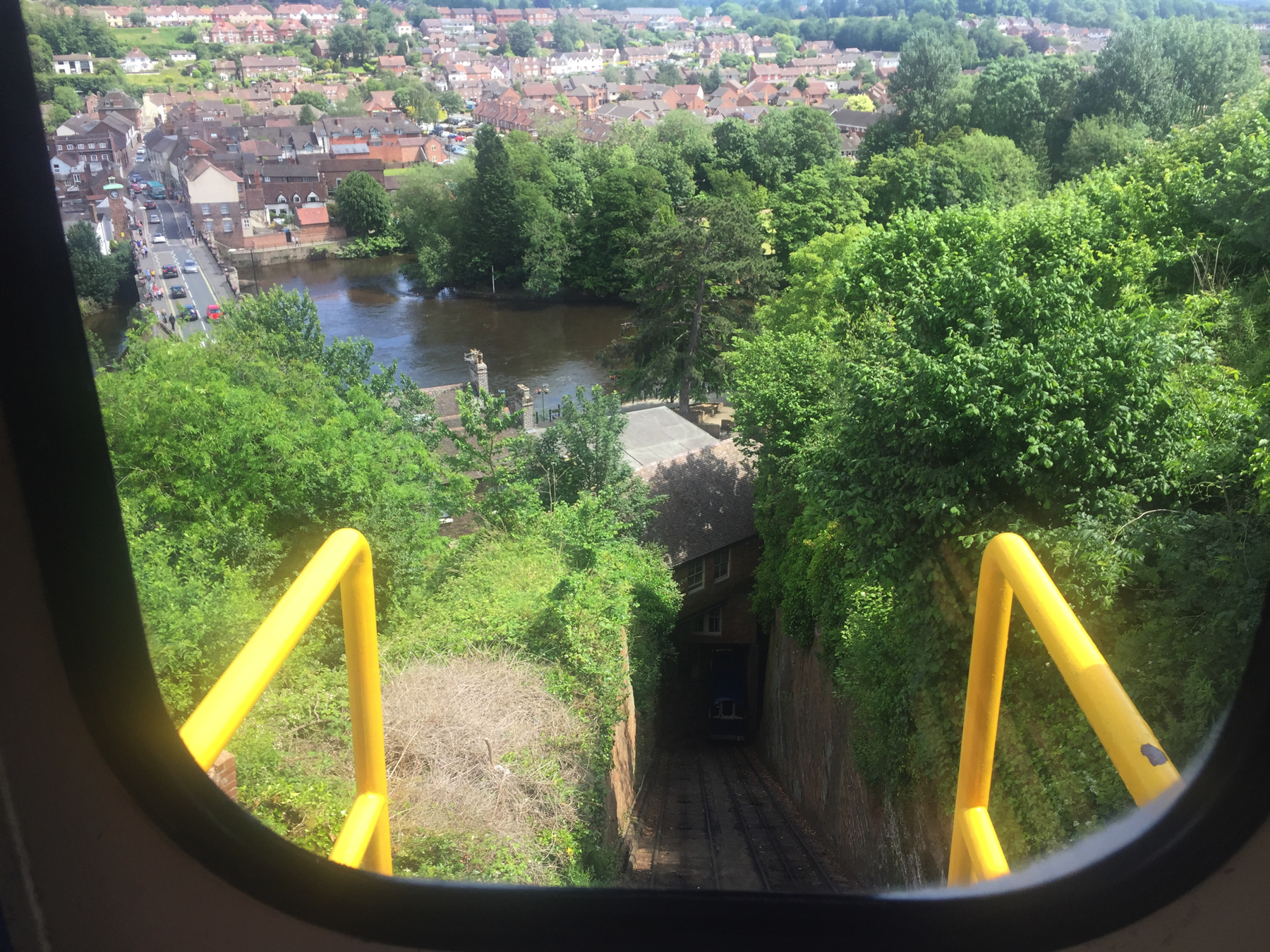
The lower station is almost hidden inside a block of buildings and accessed only from a narrow alley, but the sign with that great Cliff Railway logo is easily seen by people crossing the bridge from Low Town.
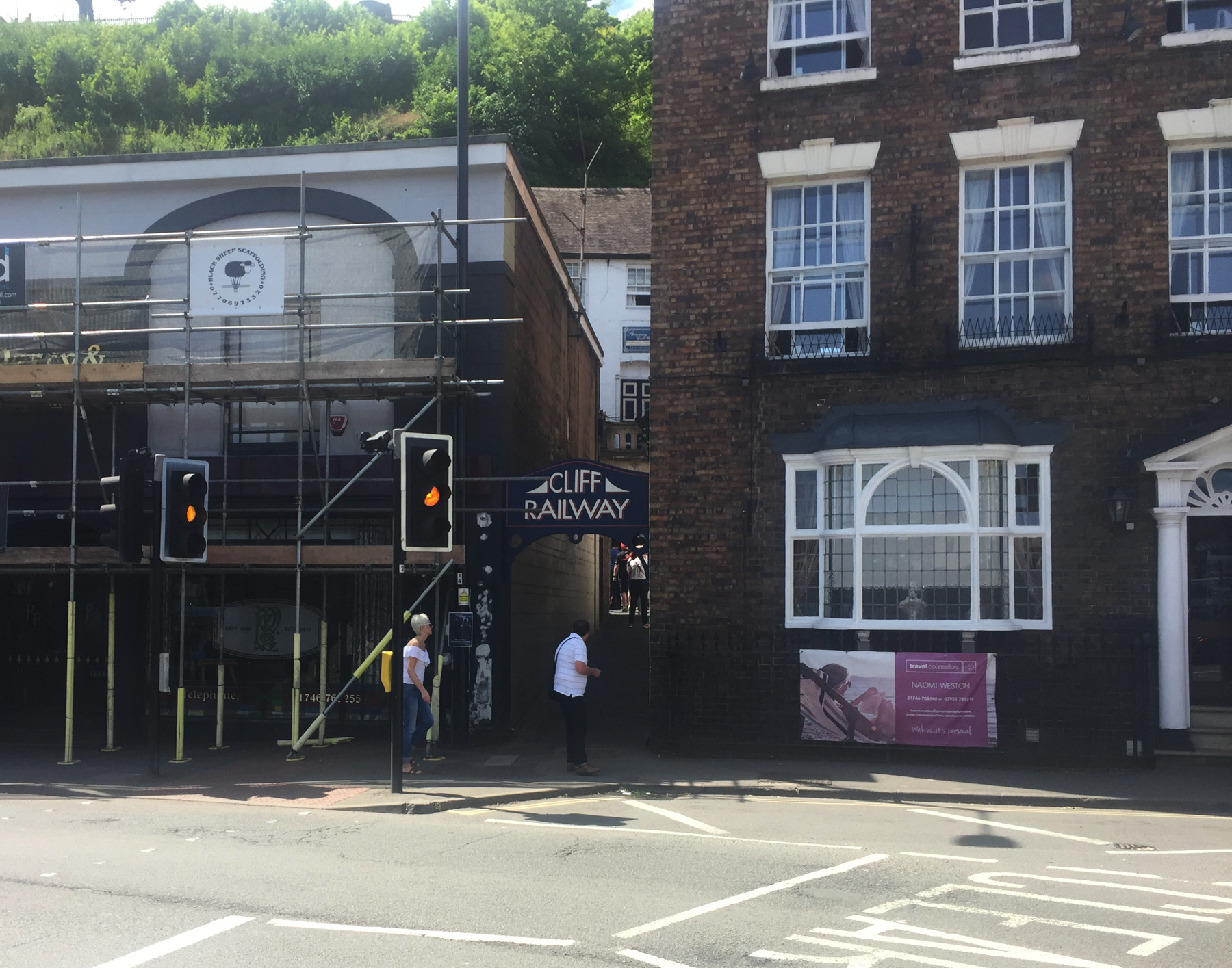
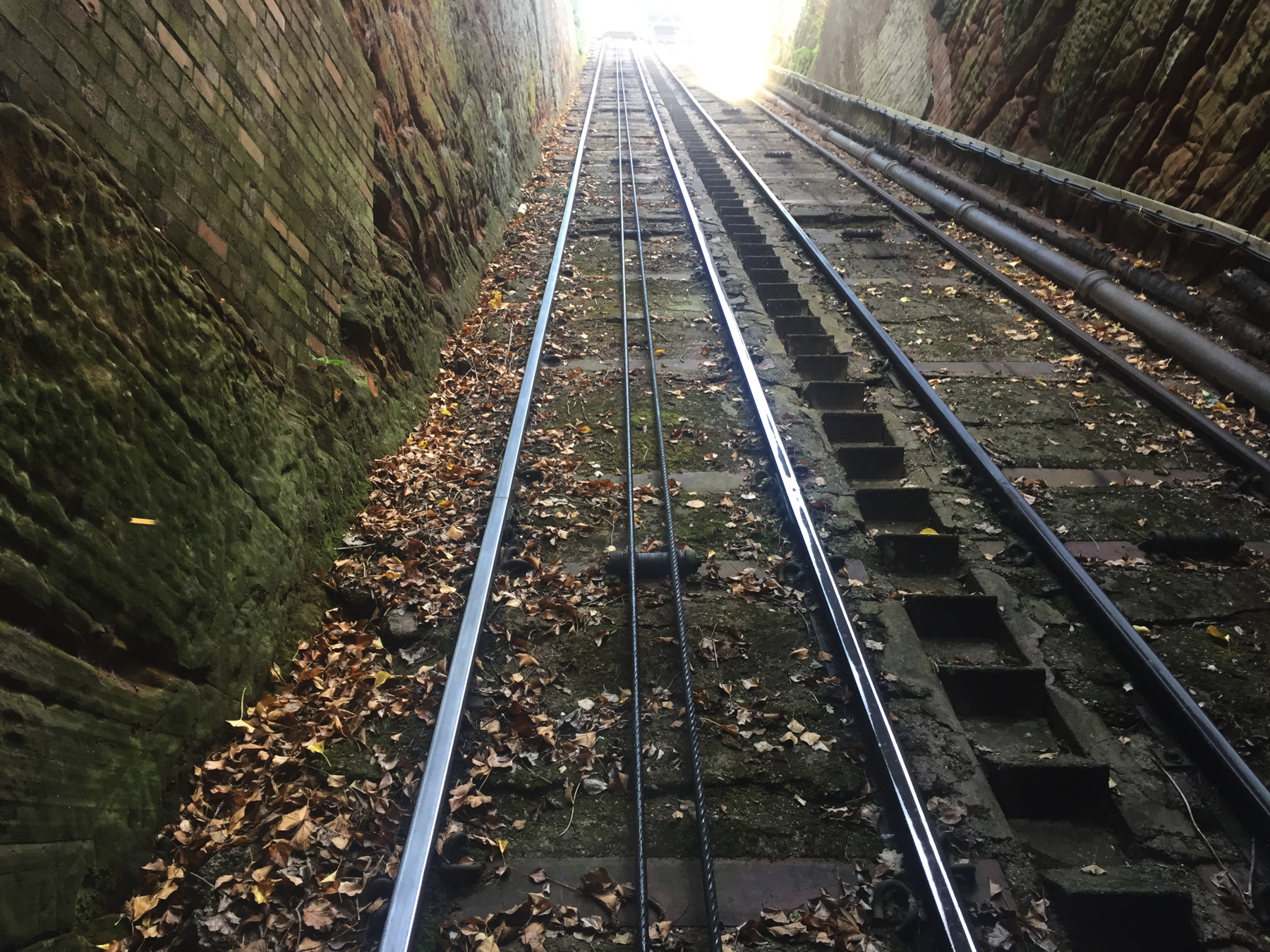
On a more technical note, we see that a double wire rope connects the upper ends of the cars, and that there is a stairway between the rails for employees maintaining the line. The side wall is a combination of bedrock stone and bricks. Yes the bricks are laid horizontally, though it doesn't look like it.
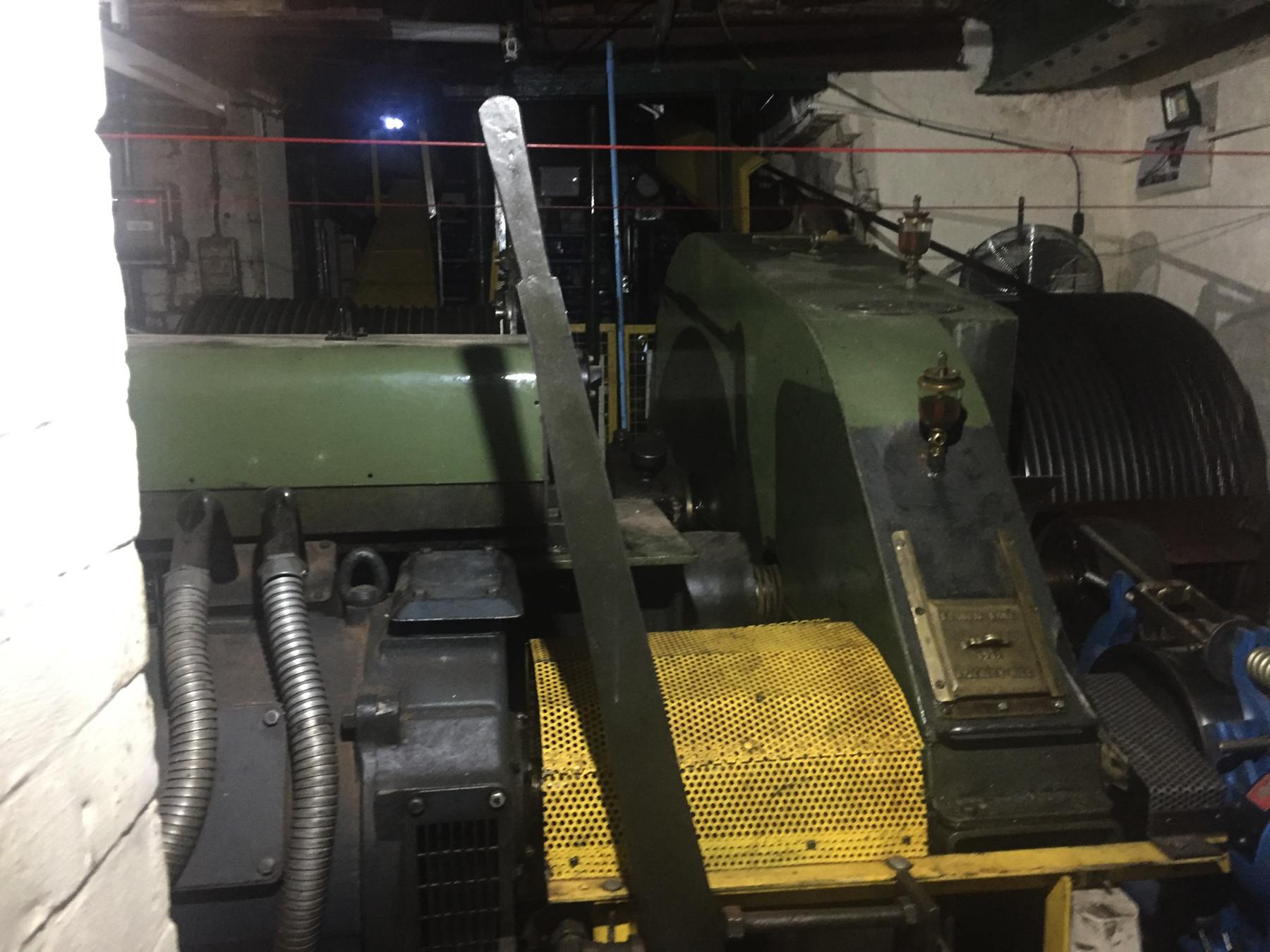
In the first picture of the upper station, you might not have noticed the Winding House Tea Room that is within the station building. Even if you are looking for something stronger, go in there, because through a window you can see the electric motor that controls the operation.
And now to return.
I walked around the east side of the castle on footpaths along gardens and greenery on the side of the hill that led me eventually to the footbridge to the Severn Valley station. I had some time to kill before the next train so I patronized the Railwayman's Arms pub on the premises. There is also a pub in the Kidderminster Town station that I did not require. Why don't American museum railways have this feature?
I decided now to travel via Birmingham. The local trains going there were frequent and I knew I could find a train to London without much delay. The trains on this line run not to New Street but to the nearby Moor Street station, which I wanted to see. When I last saw it in 2001, it was in a bad state, just two simple platforms on each side of the two tracks to Snow Hill tunnel, and a derelict terminal station gently collapsing into weeds. The terminal was closed in 1987 but came back to life in 2010. The station house and platforms were renovated in a 1930s style, and the platforms on the Snow Hill tunnel line (not original) were integrated into it. I read about it, and now I saw it. Great job. I failed to get a good photograph so here is one from Wikipedia, looking from the platforms toward the entrance. This was almost a ruin twenty years ago and now it looks wonderful.
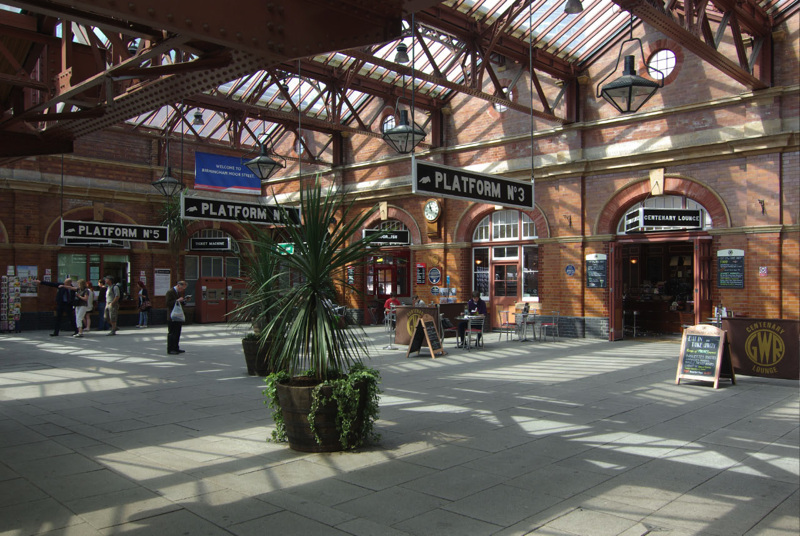
(above) Photo by Stephen McKay.
This file is licensed under the CC BY-SA 2.0, Link
I had time to grab a cake and some good coffee before the station cafe closed down. I probably could have got to London faster by walking over to New Street for a train to Euston, but I like Chiltern Railways. It's not as fast but they have very comfortable trains and no reservations so I knew I would get a good seat and no anxiety. The trains come in to London Marylebone, which was never quite abandoned but came close in the 1990s. Here is my picture from another trip in 2017 with more setting sun than on this trip. There are two mysterious figures. I wonder what their next moves were.
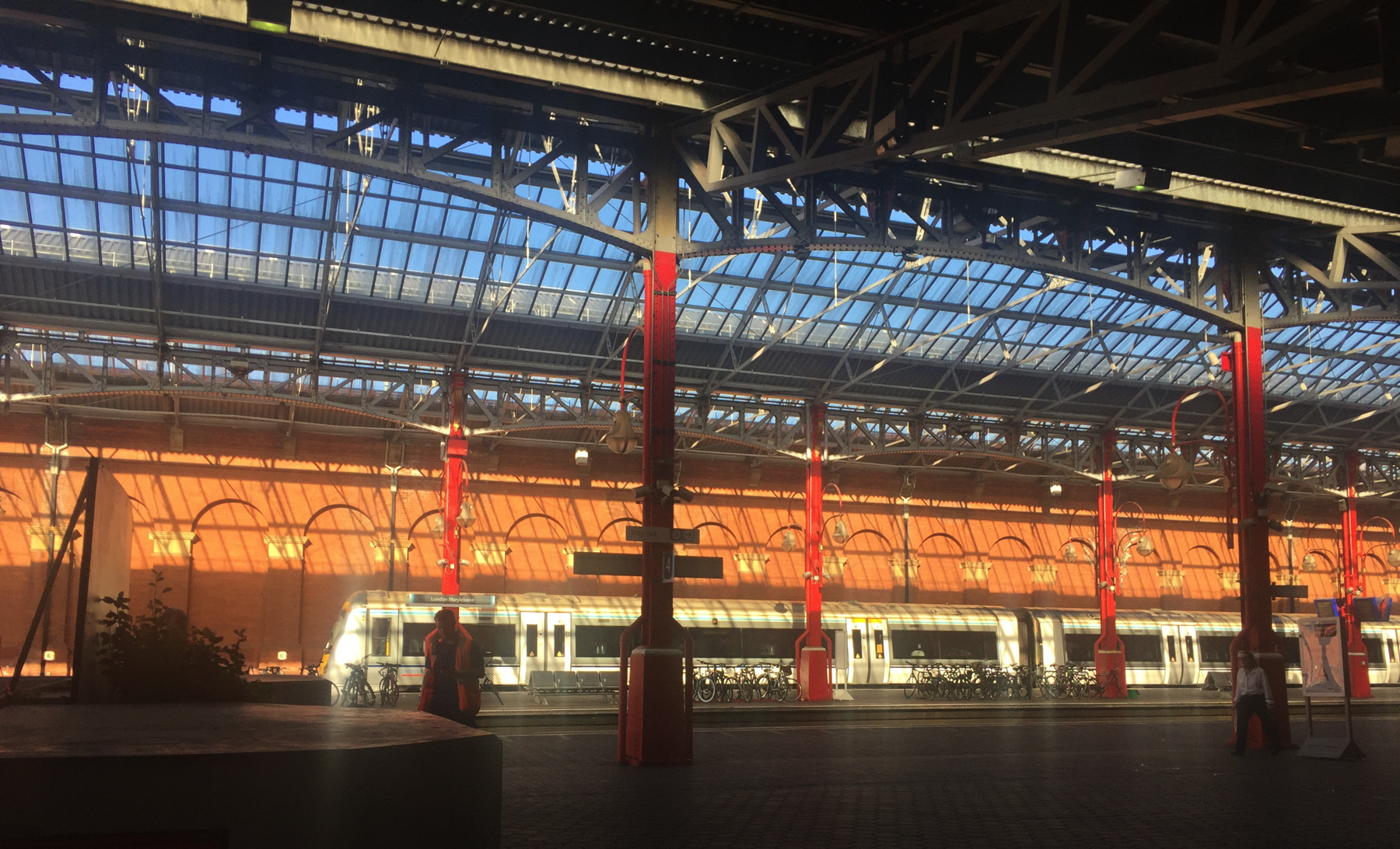
That's all for today.
[note 1] Mention of the West Somerset Railway reminds me that on certain summer Saturdays the Great Western Railway runs shuttle trains from Taunton to Bishops Lydeard, connecting with the West Somerset Railway, which in turn runs to Minehead. There is a heritage bus available from there to Lynmouth, providing an alternate route. I was too early in the summer to take advantage of this. This is the earliest schedule for each service:
lv London Paddington 0702 Great Western Railway
ar Taunton 0847
lv Taunton 0939 Great Western Railway
ar Bishops Lydeard 0956
lv Bishops Lydeard 1015 West Somerset Railway
ar Minehead 1135
lv Minehead 1405 Quantock Heritage bus
ar Lynmouth 1510
This would be competitive with the routing I used via Exeter and Barnstaple, if the heritage bus company would put a second bus in service that connects with the second West Somerset train, the one shown here. The first run from "Minehead WSR Station" leaves at 1005, too early for any WSR train, and the second run is four hours later as shown—because it is the same bus. A second bus at 1205 would get to Lynmouth at 1310, six hours.
Two and a half hours at Minehead, a place that lists a W.H. Smith and a Boots as points of interest, is hardly necessary.
What if we shorten the journey by leaving later? It can be done in six hours, if a five minute connection at Minehead does not scare you:
lv London Paddington 0903 Great Western Railway
ar Taunton 1045
lv Taunton 1210 Great Western Railway
ar Bishops Lydeard 1226
lv Bishops Lydeard 1240 West Somerset Railway
ar Minehead 1400
lv Minehead 1405 Quantock Heritage bus
ar Lynmouth 1510
But this late start gives very little time at Lynton and Lynmouth, and creates an anxious need to check carefully the last bus and train times going back. On the up side, you have plenty of time at Taunton to scrounge something for an early lunch. Note: I am not going to try this.
TODAY'S FUNICULAR
Cliff Railway, Bridgnorth
Date: since 1892
Power: Electric motor
Rise: 118 feet
Run: [about 162 feet]
Length: 201 feet
Slope: 72%
Gauge: 3 feet 8½ inches
Track: 2 tracks, straight
Car: level floor, doors at ends
The railway was water balanced until 1944.
CLAIMS: "England's Oldest and Steepest Inland Electric Funicular Railway". Quite a few qualifications there! The only other funicular railway that is not near a coast is the Shipley Glen Tramway, and it is definitely not so steep as this one. There are a few older ones and a few steeper ones, but not inland.
HEIGHT: The given track length of 201 feet and rise of 118 feet gives a calculated run of 162 feet, and that looks about right as measured on an Ordnance Survey map.
TODAY'S ALE
White Lion, Bridgnorth: Hop and Stagger Brewery, Beckbury bitter (cask ale)
Railwayman's Arms, Kidderminster: Batham's Brewery, Best Bitter (cask ale)